 At long last, the day had come: I was going to visit CERN. For 50 years, the European Center for Nuclear Research (frenchify that to get the CERN acronym) has been home to particle accelerators of increasing power. Particle accelerators are basically state of the art microscopes, the most extreme instruments we have to be able to peer into the structure of the atom. Particle accelerators are rather crude, simply smashing atoms together and watching the pieces that fly out of the collision, and each generation accelerator gets better and better by essentially smashing the atoms together harder and harder.
At long last, the day had come: I was going to visit CERN. For 50 years, the European Center for Nuclear Research (frenchify that to get the CERN acronym) has been home to particle accelerators of increasing power. Particle accelerators are basically state of the art microscopes, the most extreme instruments we have to be able to peer into the structure of the atom. Particle accelerators are rather crude, simply smashing atoms together and watching the pieces that fly out of the collision, and each generation accelerator gets better and better by essentially smashing the atoms together harder and harder.
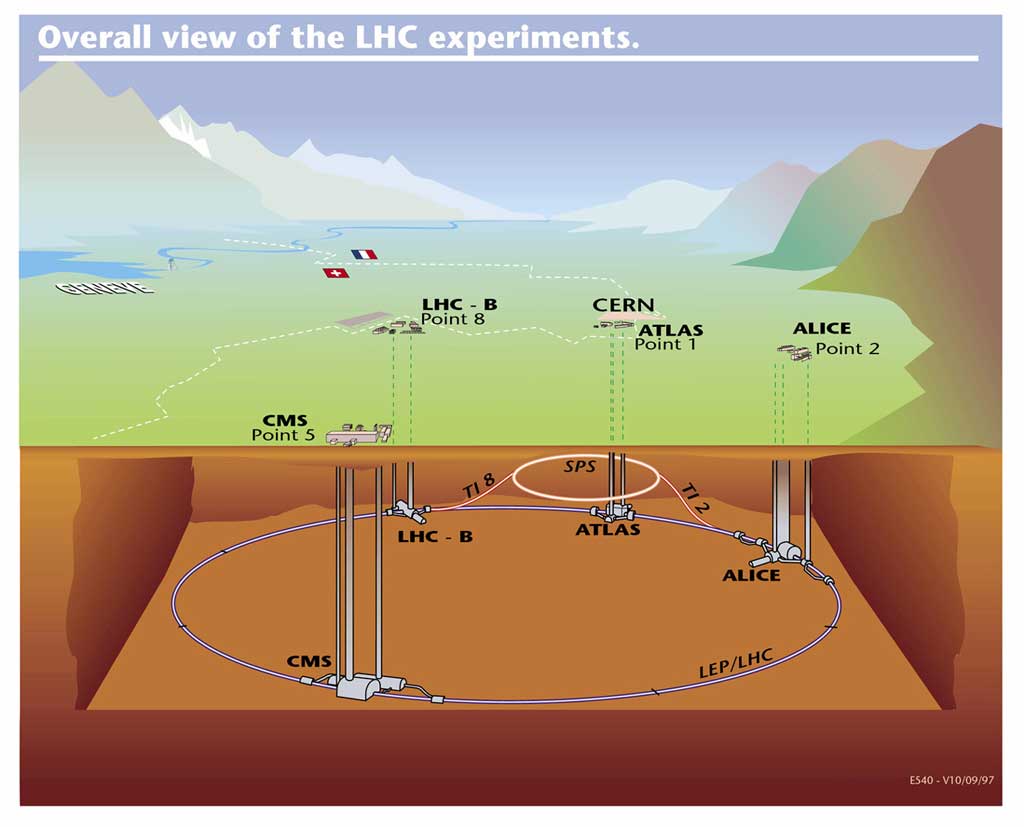 From the 1950s through the 1980s, CERN operated a series of accelerators, starting with a 600 MeV ring and ending with a 62 GeV system. The “eV” in there stand for “electron Volt“, and is how they measure how fast the atoms are going before they smash into each other. These units are metric, and use the SI system, so you’ll see a letter in front of the “eV” signifying how many multiples of 1000 to apply. So 1 MeV is one million eV (10 to the 6th power, or 10^6), 1 GeV is one billion eV (10^9), and 1 TeV is one trillion eV (10^12). It’s like computer hard drives, which were sized in MB (megabytes) in the early days, then GB, and lately TB.
From the 1950s through the 1980s, CERN operated a series of accelerators, starting with a 600 MeV ring and ending with a 62 GeV system. The “eV” in there stand for “electron Volt“, and is how they measure how fast the atoms are going before they smash into each other. These units are metric, and use the SI system, so you’ll see a letter in front of the “eV” signifying how many multiples of 1000 to apply. So 1 MeV is one million eV (10 to the 6th power, or 10^6), 1 GeV is one billion eV (10^9), and 1 TeV is one trillion eV (10^12). It’s like computer hard drives, which were sized in MB (megabytes) in the early days, then GB, and lately TB.
 In 1989, CERN started up the Large Electron–Positron Collider (LEP), which offered collision energies of 200+ GeV (or 0.200 TeV). To achieve this, they built a huge, circular tunnel under the farmland that surrounded CERN, measuring about 12 feet (4 m) wide and 17 miles (27 km) in circumference. Inside that tunnel, they built the electronic pipes that hurled the two beams in two opposite directions around the ring. The LEP ran for 11 years, but was frequently outperformed by US accelerators like the Tevatron.
In 1989, CERN started up the Large Electron–Positron Collider (LEP), which offered collision energies of 200+ GeV (or 0.200 TeV). To achieve this, they built a huge, circular tunnel under the farmland that surrounded CERN, measuring about 12 feet (4 m) wide and 17 miles (27 km) in circumference. Inside that tunnel, they built the electronic pipes that hurled the two beams in two opposite directions around the ring. The LEP ran for 11 years, but was frequently outperformed by US accelerators like the Tevatron.
 In 2000, after years of planning, they shut down the LEP and started dismantling it. In its place, in the same tunnel, they would build the Large Hadron Collider (LHC), which would have the same physical dimensions, but would make use of the latest technology to achieve vastly higher energies (speeds). The LHC is designed to hurl particles at energies of 7 TeV in each beam, thus colliding at energies of 14 TeV, or 14,000 GeV, or 70 times more powerful than the LEP that previously occupied the same tunnel. Foremost of the new technologies was superconduction, which can be used to make insanely powerful magnets, which are then strong enough to “steer” a much more powerful particle beam around that same ring. Like they say in NASCAR, go fast and turn left. However, to get those magnets to work, you need to supercool them, hundreds of degrees below what we would call normal.
In 2000, after years of planning, they shut down the LEP and started dismantling it. In its place, in the same tunnel, they would build the Large Hadron Collider (LHC), which would have the same physical dimensions, but would make use of the latest technology to achieve vastly higher energies (speeds). The LHC is designed to hurl particles at energies of 7 TeV in each beam, thus colliding at energies of 14 TeV, or 14,000 GeV, or 70 times more powerful than the LEP that previously occupied the same tunnel. Foremost of the new technologies was superconduction, which can be used to make insanely powerful magnets, which are then strong enough to “steer” a much more powerful particle beam around that same ring. Like they say in NASCAR, go fast and turn left. However, to get those magnets to work, you need to supercool them, hundreds of degrees below what we would call normal.
 The United States had planned to build a similar particle accelerator on the same principles, but one that would have utterly dwarfed even today’s LHC. It was called the Superconducting Super Collider (SSC) and construction actually got underway in east Texas in the 1980s, but the construction cost (54 miles of tunnels!) became too much for the federal budget to bear, and it was cancelled. Thus began a sort of “brain drain”, where our best physicists started to gravitate towards Europe where CERN was building the LHC. Further, in some cases the lure of filthy lucre became too great, and many of these physicists ended up on Wall Street as “quants”, essentially harnessing their command of advanced mathematics to model the financial markets and create new ways to conjure money out of thin air. I’ve heard it argued, perhaps in jest, that the $750 billion bailout of our financial markets in 2008 could have been avoided by simply spending a few billion dollars on the SSC …
The United States had planned to build a similar particle accelerator on the same principles, but one that would have utterly dwarfed even today’s LHC. It was called the Superconducting Super Collider (SSC) and construction actually got underway in east Texas in the 1980s, but the construction cost (54 miles of tunnels!) became too much for the federal budget to bear, and it was cancelled. Thus began a sort of “brain drain”, where our best physicists started to gravitate towards Europe where CERN was building the LHC. Further, in some cases the lure of filthy lucre became too great, and many of these physicists ended up on Wall Street as “quants”, essentially harnessing their command of advanced mathematics to model the financial markets and create new ways to conjure money out of thin air. I’ve heard it argued, perhaps in jest, that the $750 billion bailout of our financial markets in 2008 could have been avoided by simply spending a few billion dollars on the SSC …
 I should mention that it’s not just the “eV” power of the accelerator that matters. How those beams get focused, and how the data gets analyzed, are also crucial performance issues that drive how productive an accelerator is.
I should mention that it’s not just the “eV” power of the accelerator that matters. How those beams get focused, and how the data gets analyzed, are also crucial performance issues that drive how productive an accelerator is.
Where was I? Oh, right, visiting CERN. OK, let’s get on with it then.
By nice coincidence (actually some planning), the streetcar that ran past my hotel would take me straight to CERN. CERN is out in the suburbs of Geneva, at the very end of the streetcar line that they had only recently extended out there. All I had to do was hop on, watch Geneva go by for about 30 minutes, and at the end of the line I’d be in the center of the most cutting edge scientific research facility on the face of the planet.
 The public face of the CERN complex is a surprisingly modest visitors center, but it hides a large museum, containing seemingly every artifact of 50 years of exploration at the smallest scales. Hardware of all shapes and sizes, displays and movies that explain what they do, examples of how computer storage worked back in the day … In a courtyard that we couldn’t get to, but could see through the windows, they had all sorts of impossibly exotic gear mounted and displayed, literally put out to pasture outside. Signs, signs, I have to read the signs!
The public face of the CERN complex is a surprisingly modest visitors center, but it hides a large museum, containing seemingly every artifact of 50 years of exploration at the smallest scales. Hardware of all shapes and sizes, displays and movies that explain what they do, examples of how computer storage worked back in the day … In a courtyard that we couldn’t get to, but could see through the windows, they had all sorts of impossibly exotic gear mounted and displayed, literally put out to pasture outside. Signs, signs, I have to read the signs!
To the tour! Months prior to this, I had checked the CERN website and found that while they do offer tours that go to interesting places (e.g. down into the tunnel, not just surface buildings), there weren’t any tours available in my timeframe. Oh no! One day later, after an eloquent and pleading email to their tour managers, I had a spot on some other group’s tour. And they confirmed that we would go down into the tunnel!
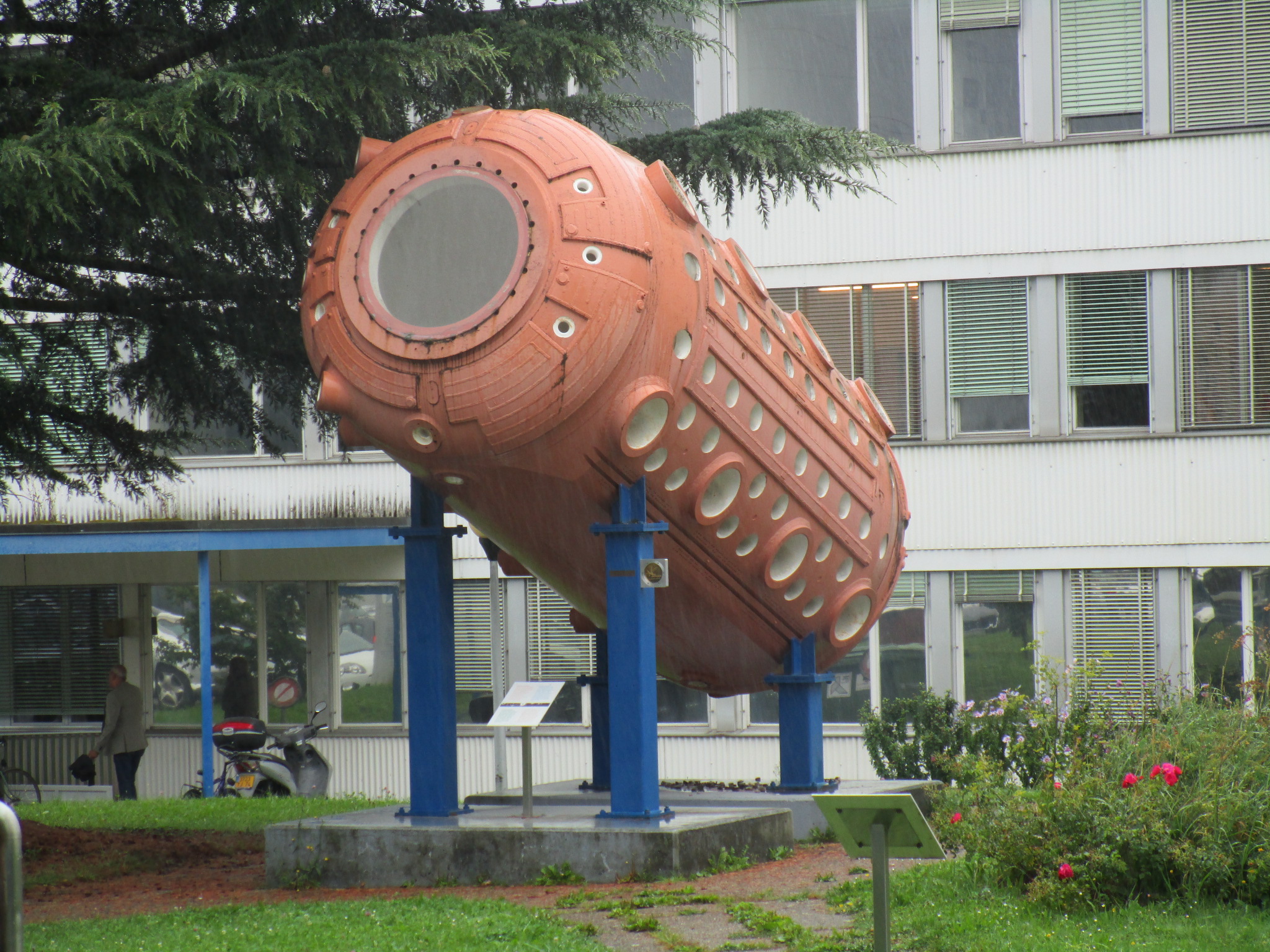 Being able to see the tunnel was actually quite a unique opportunity. As a high energy physics experiment, when the beams are running, it’s quite radioactive in the tunnel, and nobody is allowed in there, not even workers. Like a nuclear power plant, everyone clears out of the tunnel and they seal the doors before starting the sequence to fire up the machine. Well, 2013-2014 was a major period or planned downtime, when they would be really shutting the machine down, and basically taking it apart and refurbishing it. So during that extended downtime, they were letting the public get even closer to the equipment than they normally would. However, the shutdown was coming to an end, and some parts of the tunnel were already off limits to even CERN workers. This timing is why I made the effort in the first place to get to Geneva on this trip.
Being able to see the tunnel was actually quite a unique opportunity. As a high energy physics experiment, when the beams are running, it’s quite radioactive in the tunnel, and nobody is allowed in there, not even workers. Like a nuclear power plant, everyone clears out of the tunnel and they seal the doors before starting the sequence to fire up the machine. Well, 2013-2014 was a major period or planned downtime, when they would be really shutting the machine down, and basically taking it apart and refurbishing it. So during that extended downtime, they were letting the public get even closer to the equipment than they normally would. However, the shutdown was coming to an end, and some parts of the tunnel were already off limits to even CERN workers. This timing is why I made the effort in the first place to get to Geneva on this trip.
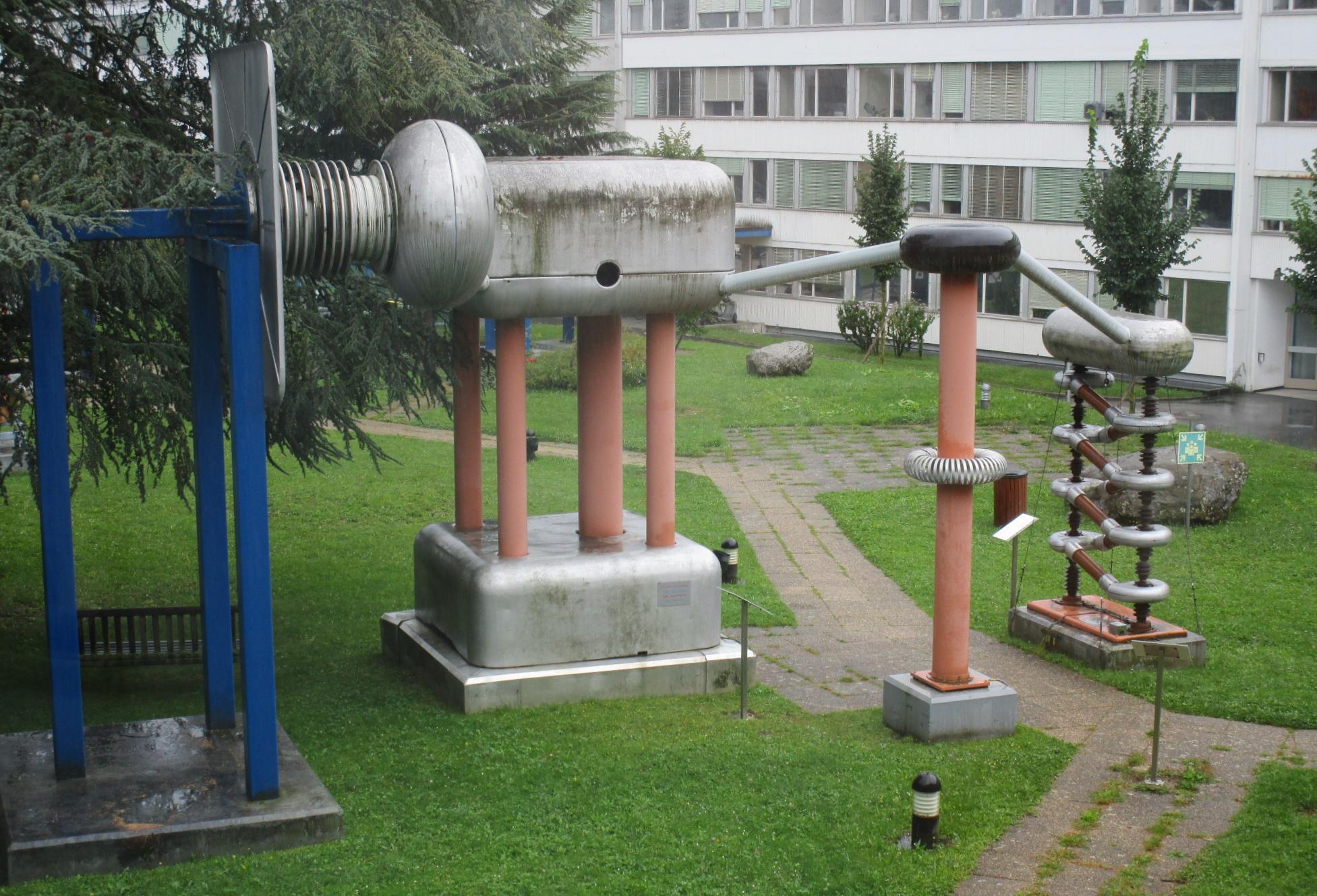 The CERN folks corralled us onto a bus and we headed off into the Swiss countryside. Well, actually, the French countryside, because right after pulling out of the parking lot, we crossed the Swiss-French border. There hasn’t been any border control in most of Europe since the Schengen Area was agreed to in the mid-90s, which the Swiss finally joined in 2008. So there are all these abandoned border posts, and we just drove right through it.
The CERN folks corralled us onto a bus and we headed off into the Swiss countryside. Well, actually, the French countryside, because right after pulling out of the parking lot, we crossed the Swiss-French border. There hasn’t been any border control in most of Europe since the Schengen Area was agreed to in the mid-90s, which the Swiss finally joined in 2008. So there are all these abandoned border posts, and we just drove right through it.
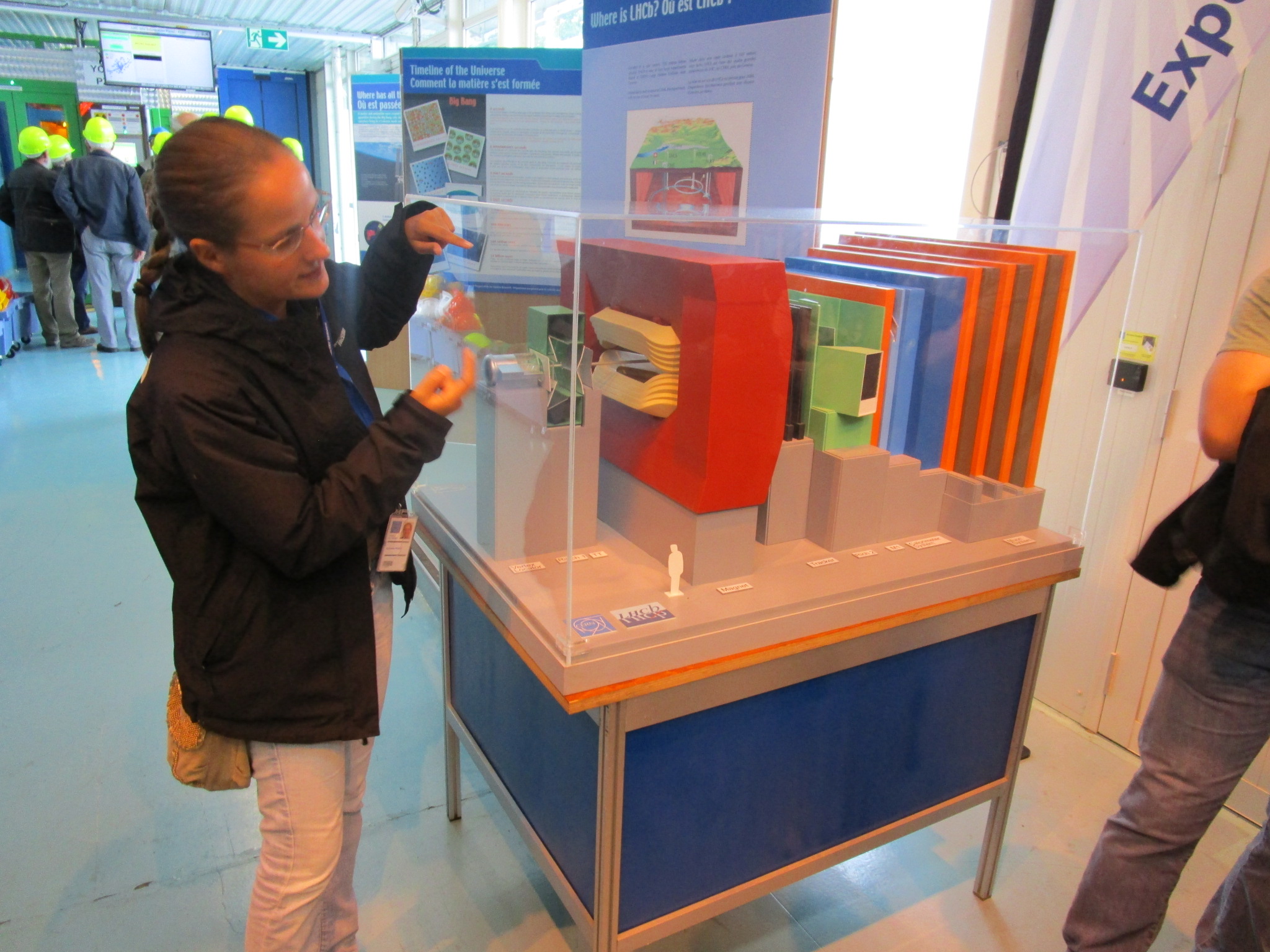 Our first stop would be the LHCb. At each of four points around the 17-mile ring, CERN built a massive underground cavern around the precise spot where they would collide the beams. With a 7 TeV beam going in one direction around the ring, and a 7 TeV beam going the other direction, they would have 14 TeV collision energies, and the cavern was built to house the colossal machinery that would be needed to detect and measure the sub-atomic bits that came flying off. The “LHC-beauty” experiment was one of those four collision points, and was designed to examine and characterize the “beauty” particle, so named because physicists have a sense of humor …
Our first stop would be the LHCb. At each of four points around the 17-mile ring, CERN built a massive underground cavern around the precise spot where they would collide the beams. With a 7 TeV beam going in one direction around the ring, and a 7 TeV beam going the other direction, they would have 14 TeV collision energies, and the cavern was built to house the colossal machinery that would be needed to detect and measure the sub-atomic bits that came flying off. The “LHC-beauty” experiment was one of those four collision points, and was designed to examine and characterize the “beauty” particle, so named because physicists have a sense of humor …
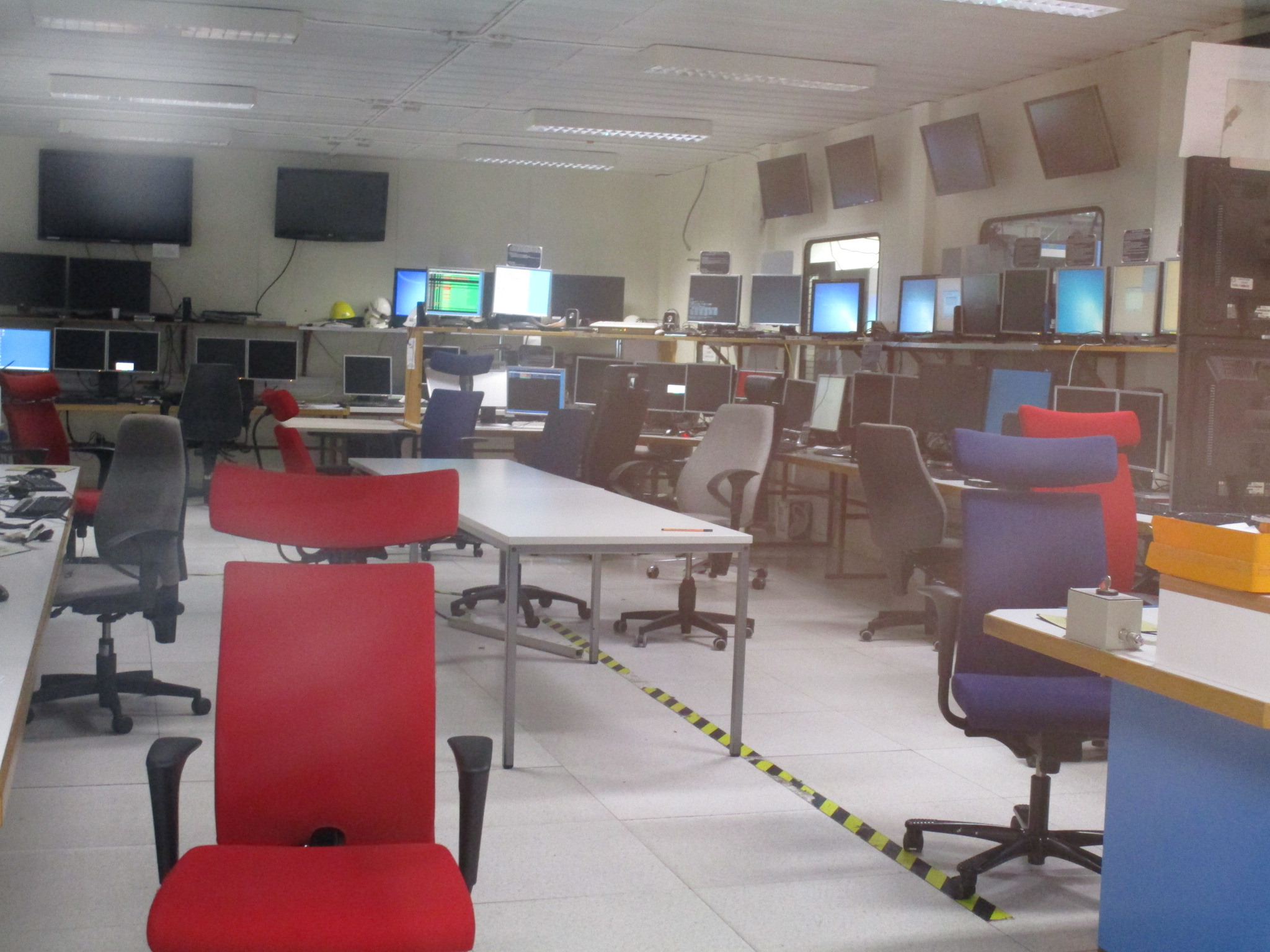 Our tour guide was a young Polish physicist named Agnieszka, and she led us first through the small displays they had set up in a waiting area at the surface level. The bulk of the machinery was below us, but they still need a hall at the surface to stage material and raise from / lower to the tunnel. Also up here was the main control room, unmanned because of the long-term shutdown, but which would be humming again soon enough.
Our tour guide was a young Polish physicist named Agnieszka, and she led us first through the small displays they had set up in a waiting area at the surface level. The bulk of the machinery was below us, but they still need a hall at the surface to stage material and raise from / lower to the tunnel. Also up here was the main control room, unmanned because of the long-term shutdown, but which would be humming again soon enough.
 Right about this point is where I realized something horrible: my battery camera was almost dead. I had obviously been planning the logistics of this visit for a very long time, and I had packed extra camera batteries and made sure to charged them up. But I had left them at the hotel! Oh shiiiiiiiiit. I was about to into the CERN tunnel, and my camera would be dead!
Right about this point is where I realized something horrible: my battery camera was almost dead. I had obviously been planning the logistics of this visit for a very long time, and I had packed extra camera batteries and made sure to charged them up. But I had left them at the hotel! Oh shiiiiiiiiit. I was about to into the CERN tunnel, and my camera would be dead!
Now I started to be very miserly about photos, and the camera’s power. Turn camera on, take a photo, turn off. In the end, I got the minimum amount of pictures I needed to be happy, but it was a stupid mistake.
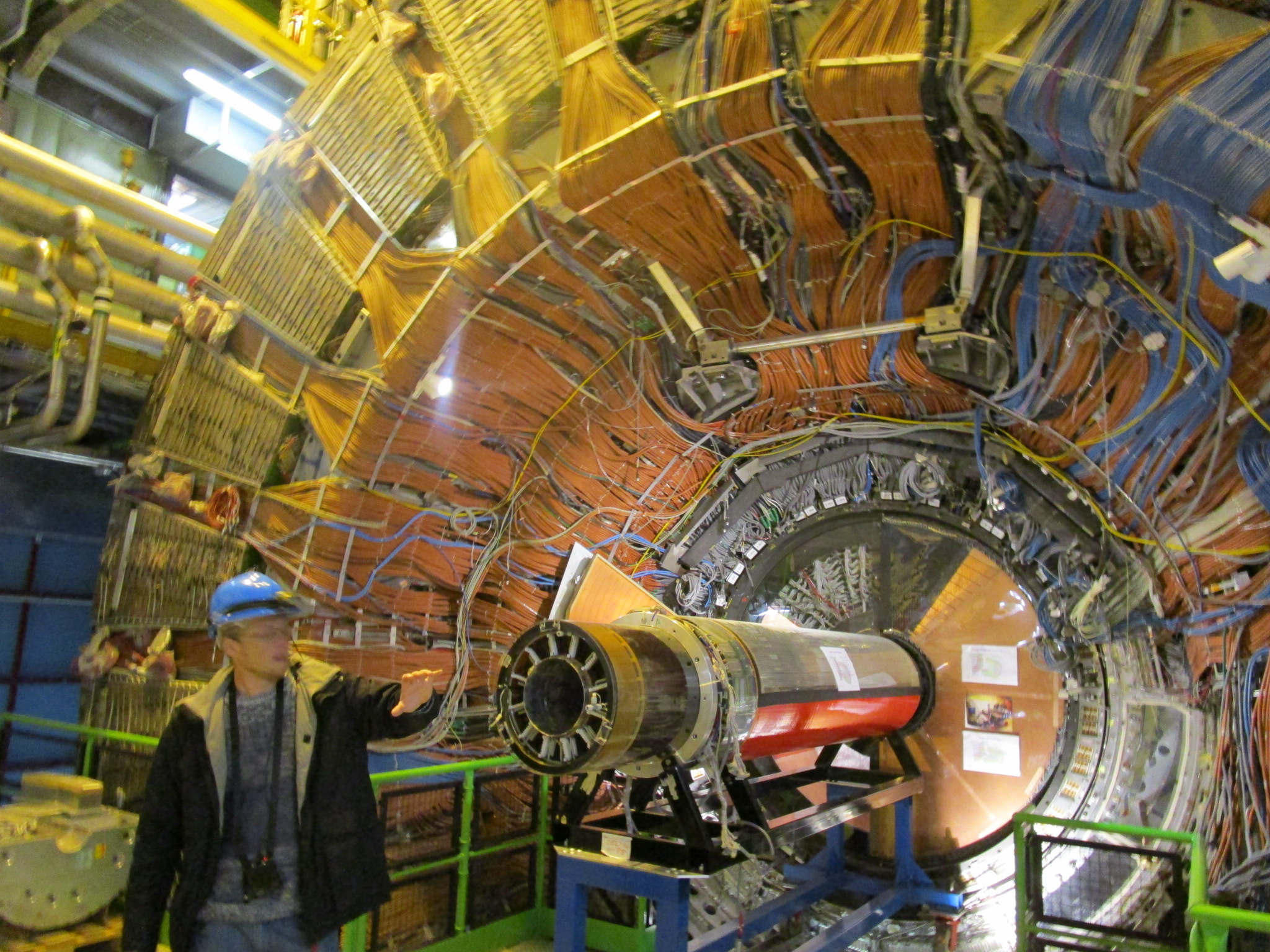 Agnieszka handed us off to her colleague (and fellow Pole) Rafal, who would take us down to the tunnel. They handed us all hardhats (color coded to our tour group) and had us go through the security checkpoint. This was basically a fancier version of what you go through at the airport, or what I used to do when working in nuclear power plants.
Agnieszka handed us off to her colleague (and fellow Pole) Rafal, who would take us down to the tunnel. They handed us all hardhats (color coded to our tour group) and had us go through the security checkpoint. This was basically a fancier version of what you go through at the airport, or what I used to do when working in nuclear power plants.
After all of us h ad scanned through, we got into a freight elevator and went down.
ad scanned through, we got into a freight elevator and went down.
Down.
Down.
About 300 feet down, we got off at one of the cavern levels. The cavern is about 70 f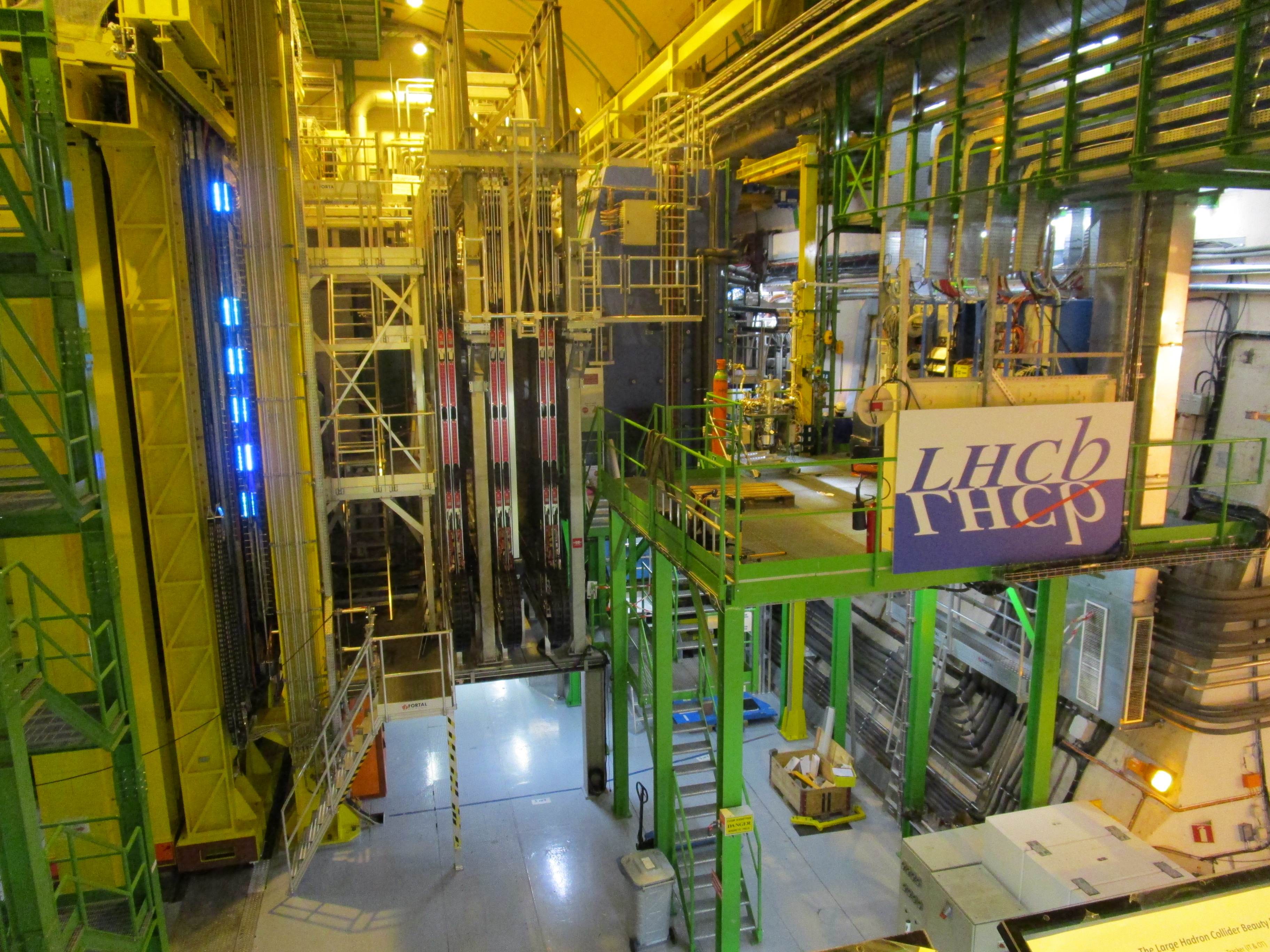 eet high, with metal lattice work forming multiple levels (stories) for workers to use to access equipment. Our first stop was in a side section of the cavern containing a monstrous instrument left over from the LEP days. This same cavern had been used in the LEP, and when they dismantled that system and started building the LHC, they had room in this cavern to just shove this instrument off to the side. Since it obviously had been decommissioned, we were allowed to get up close and personal with it.
eet high, with metal lattice work forming multiple levels (stories) for workers to use to access equipment. Our first stop was in a side section of the cavern containing a monstrous instrument left over from the LEP days. This same cavern had been used in the LEP, and when they dismantled that system and started building the LHC, they had room in this cavern to just shove this instrument off to the side. Since it obviously had been decommissioned, we were allowed to get up close and personal with it.
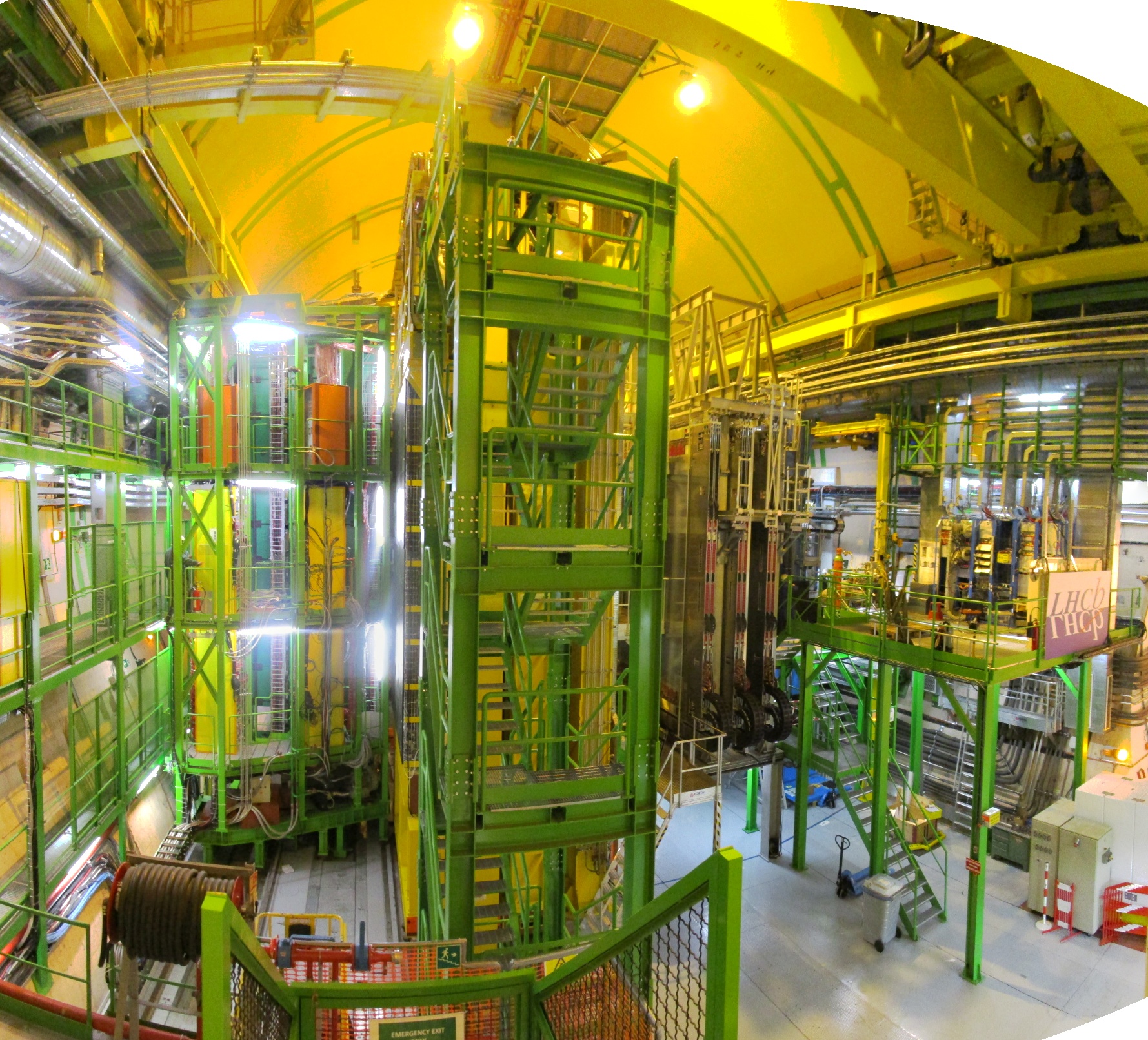
A panorama photo of the LHCb cavern!
A short walk awa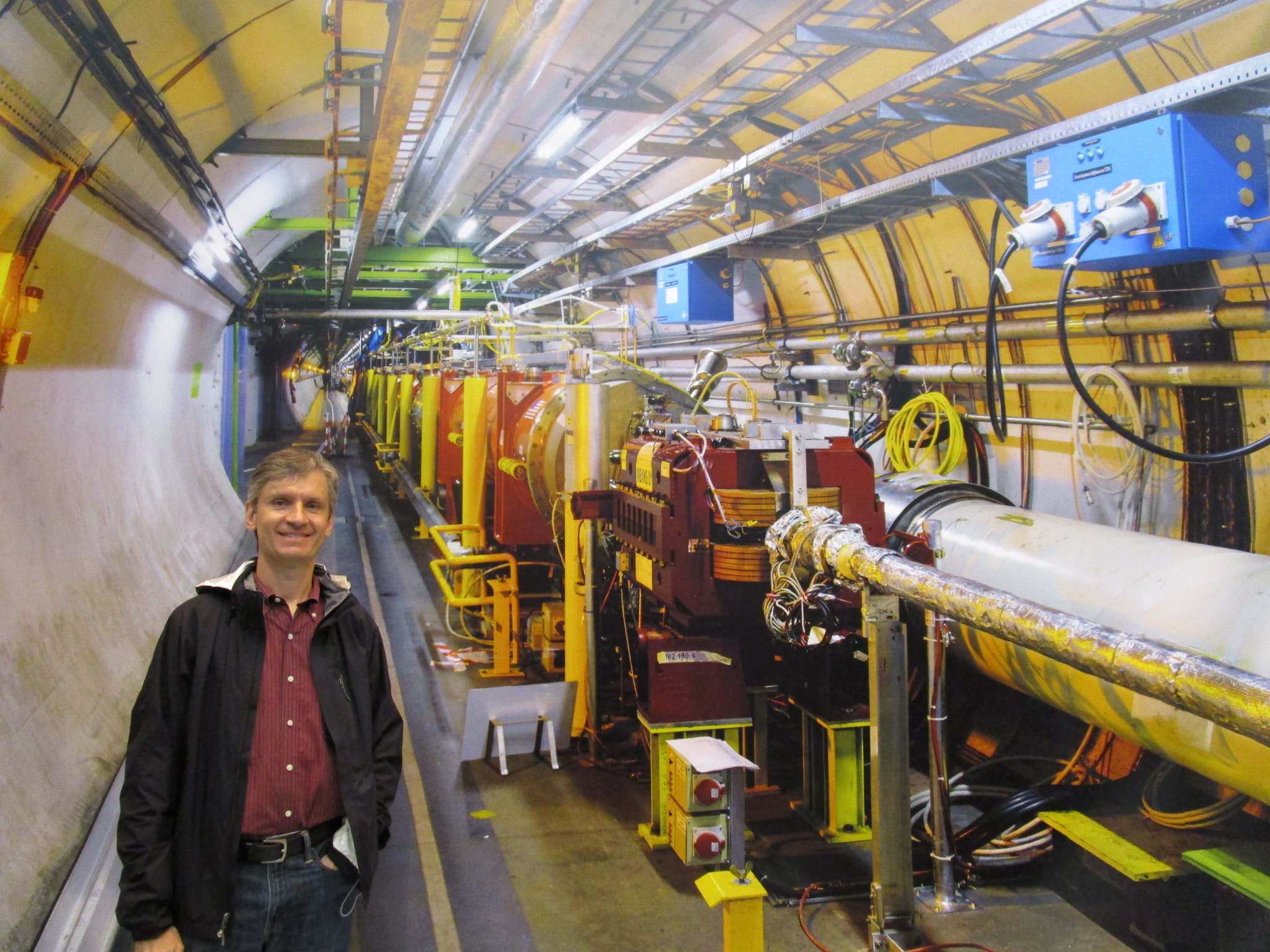 y and (cue angelic choirs) the LHCb experiment! This machine was basically a horizontal stack of vertical layers. The beam would come in from the right, the collision would occur in the right side of the cavern, and the particles would spray off to the left, through all those detector layers. If you scrutinize the smaller LHCb photo above, you will see a man wearing a yellow hardhat. Go to the upper left corner of the blue and white “LHCb” sign, go to the left past the white circle with the red object in the center, and just to the left
y and (cue angelic choirs) the LHCb experiment! This machine was basically a horizontal stack of vertical layers. The beam would come in from the right, the collision would occur in the right side of the cavern, and the particles would spray off to the left, through all those detector layers. If you scrutinize the smaller LHCb photo above, you will see a man wearing a yellow hardhat. Go to the upper left corner of the blue and white “LHCb” sign, go to the left past the white circle with the red object in the center, and just to the left of that you’ll see him.
of that you’ll see him.
On our way out, we passed a large wall that had a big picture of the tunnel on it, and we got to pose in front of it. So, it looks like I’m in the tunnel, not actually in the tunnel.
Also they had a nice p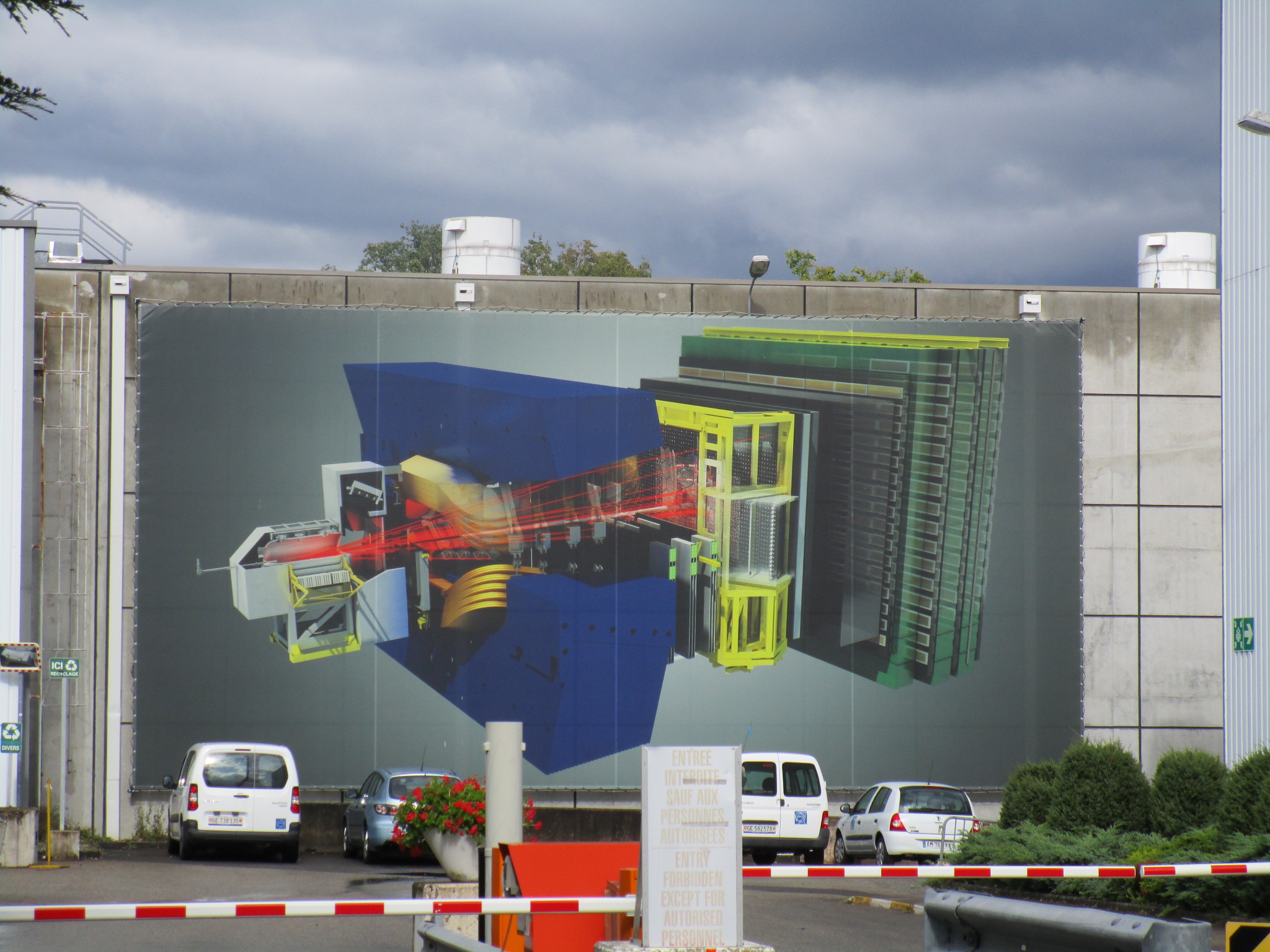 oster of the women working on LHCb. Girl Power! Also, note the Comic Sans, which is a bit of a running joke at CERN.
oster of the women working on LHCb. Girl Power! Also, note the Comic Sans, which is a bit of a running joke at CERN.
Back on the bus, back across the French country side, back across the 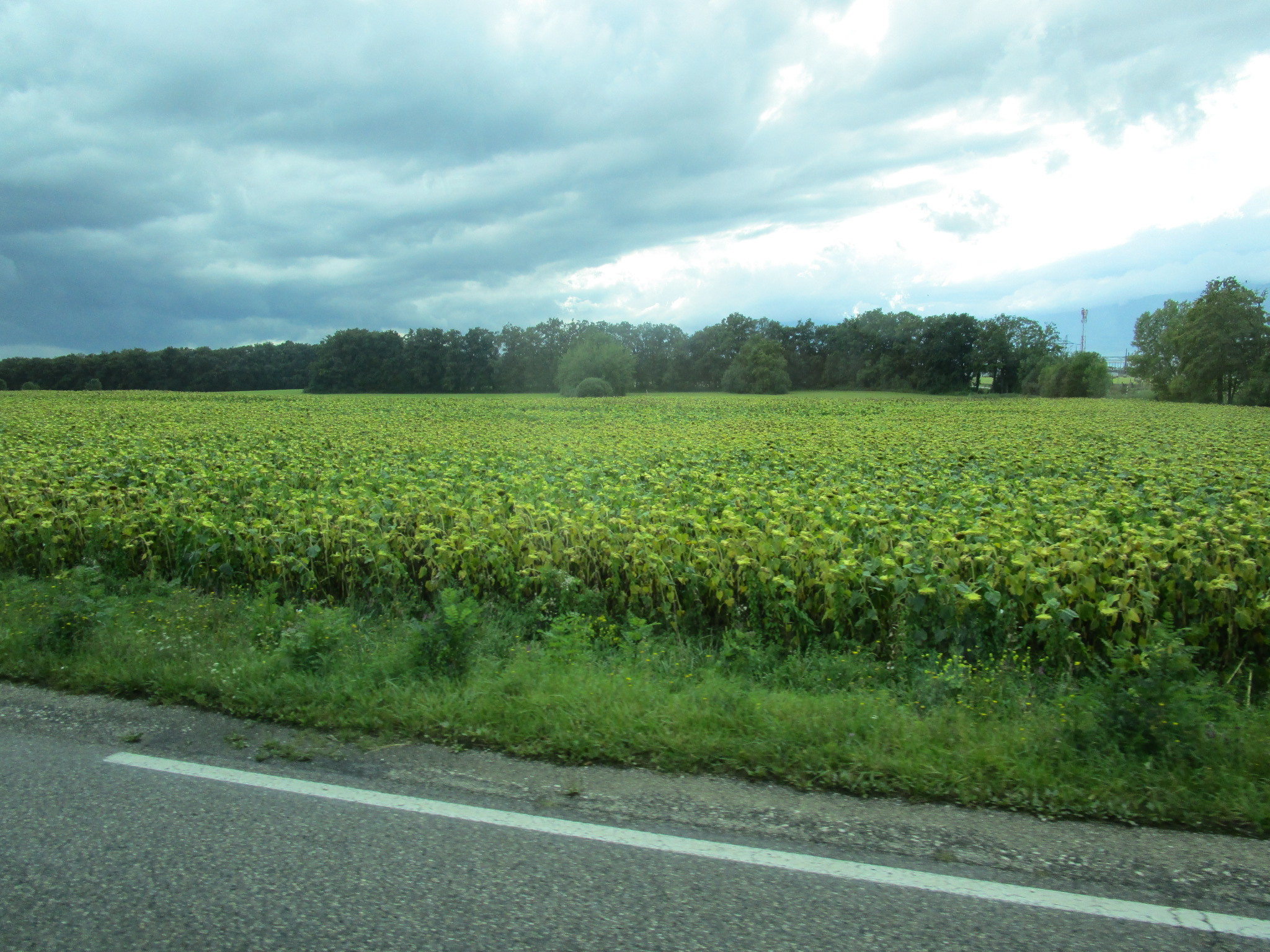 “border”, back to the visitor’s center.
“border”, back to the visitor’s center.
Now, I wasn’t done. Not even close. In short, I sweet-talked the tour operators into finding an empty spot for me to join another group on another tour tomorrow! To a different cavern! And to the magnet test facility! Oh my god, I was so happy. In fact, after I finishing writing this, I’m going to email them and send them the link to this so they know how much I appreciated it.
And now, finally, to t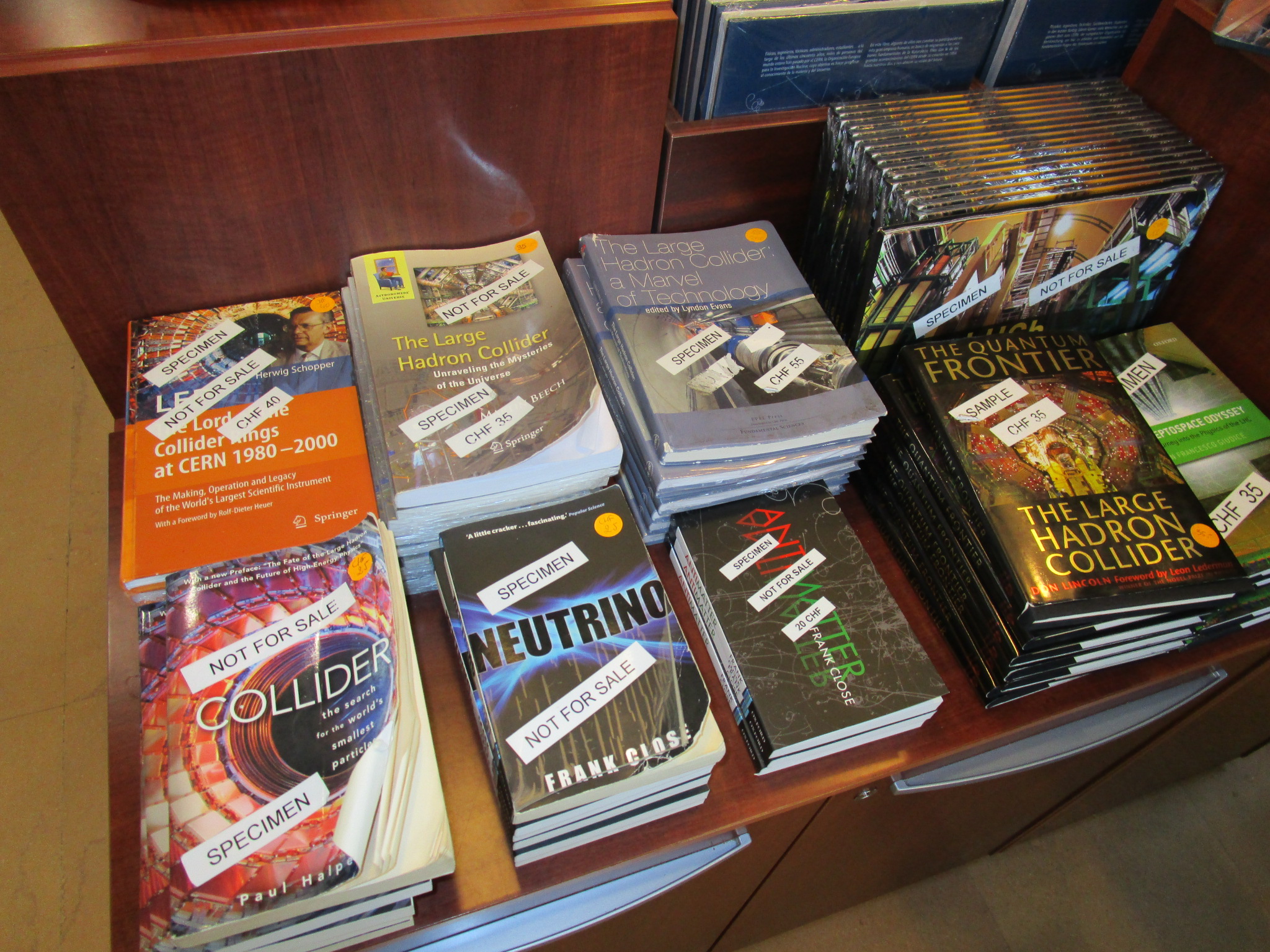 he gift store! The store was tiny (by US standards) but chock full of the most incredible books and science tchotchkes. I literally would have bought everything in the store, but everything was going to eventually need to fit into my suitcase, and later in this same trip I’d be lugging this suitcase onto a sailboat … So I bought some more compact items, took pictures of the bulkier items for future wishlist purposes, and headed back to the hotel.
he gift store! The store was tiny (by US standards) but chock full of the most incredible books and science tchotchkes. I literally would have bought everything in the store, but everything was going to eventually need to fit into my suitcase, and later in this same trip I’d be lugging this suitcase onto a sailboat … So I bought some more compact items, took pictures of the bulkier items for future wishlist purposes, and headed back to the hotel.
 After resting at the hotel for a bit, and soaking up some internet, I struck out on an evening jaunt. One of the first high-power EV charging stations had supposedly been installed in a suburb just west of Geneva. The streetcars didn’t run out there, but the busses did. So, in the failing light of mid-evening, I literally got off a bus in the middle of some strange residential neighborhood and hunted around for this charging station. Walked up and down little alleyways, through parking lots, all over the place. In the end, the charging station was located a good bit away from the map marker I was chasing — at a Volkswagen dealership, duh. But I found it!
After resting at the hotel for a bit, and soaking up some internet, I struck out on an evening jaunt. One of the first high-power EV charging stations had supposedly been installed in a suburb just west of Geneva. The streetcars didn’t run out there, but the busses did. So, in the failing light of mid-evening, I literally got off a bus in the middle of some strange residential neighborhood and hunted around for this charging station. Walked up and down little alleyways, through parking lots, all over the place. In the end, the charging station was located a good bit away from the map marker I was chasing — at a Volkswagen dealership, duh. But I found it!
 Having thoroughly explored CERN and the LHC, it was finally time to see the rest of the city. Geneva is a fabulously wealthy city in a gorgeous lakeside setting. Visitors to the city get to ride the transit system for free, so I was able to zip all over the place without really having to worry about anything other than which streetcar to get onto.
Having thoroughly explored CERN and the LHC, it was finally time to see the rest of the city. Geneva is a fabulously wealthy city in a gorgeous lakeside setting. Visitors to the city get to ride the transit system for free, so I was able to zip all over the place without really having to worry about anything other than which streetcar to get onto.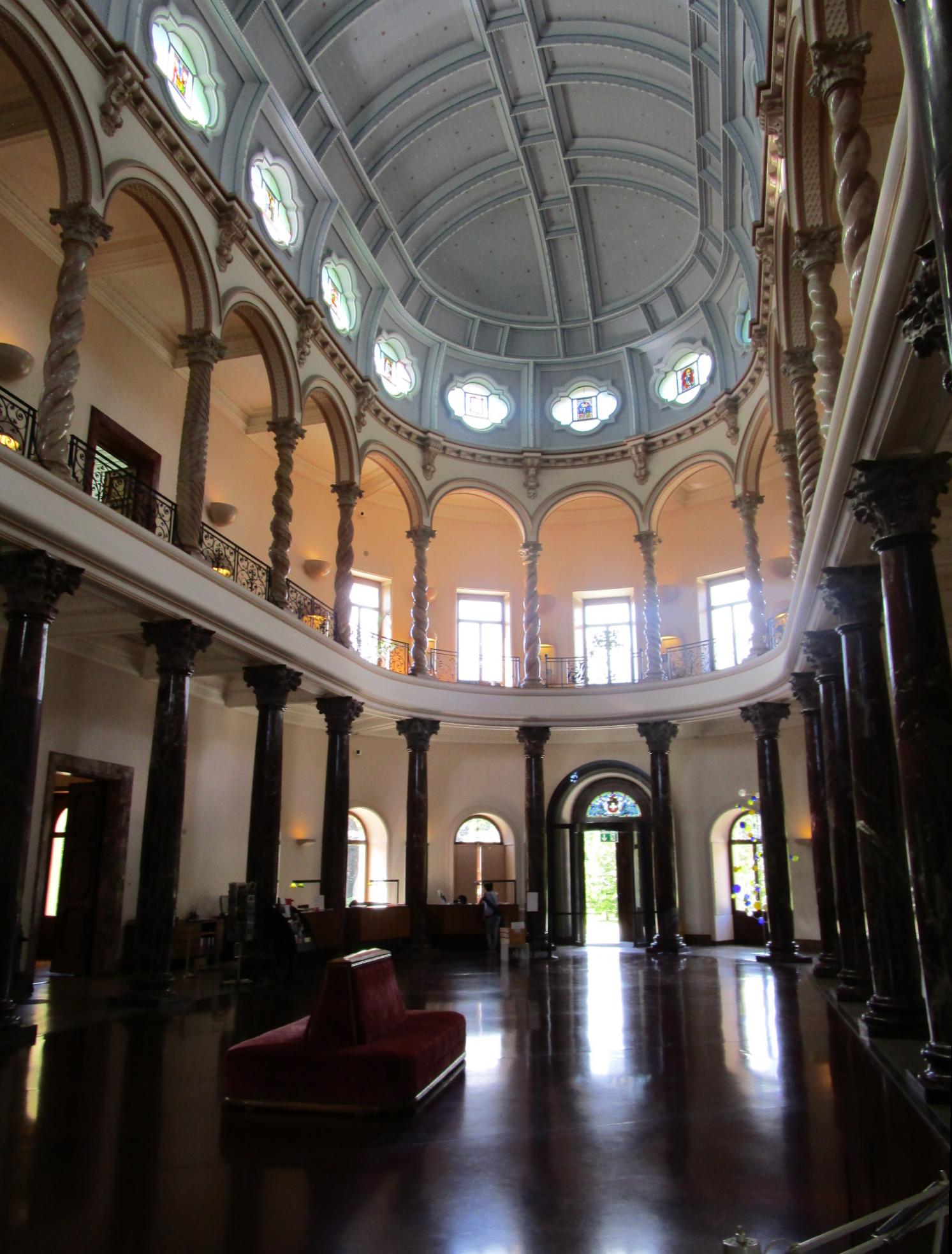 I headed over to the northeast part of town, where the United Nations campus was. Aside from the UN buildings themselves, there are a number of old mansions scattered around that have been repurposed as museums of one sort or another. First stop was the Musee Ariana, a serene 1880s structure that actually wasn’t built as a residence, rather was designed to house artwork from the beginning.
I headed over to the northeast part of town, where the United Nations campus was. Aside from the UN buildings themselves, there are a number of old mansions scattered around that have been repurposed as museums of one sort or another. First stop was the Musee Ariana, a serene 1880s structure that actually wasn’t built as a residence, rather was designed to house artwork from the beginning.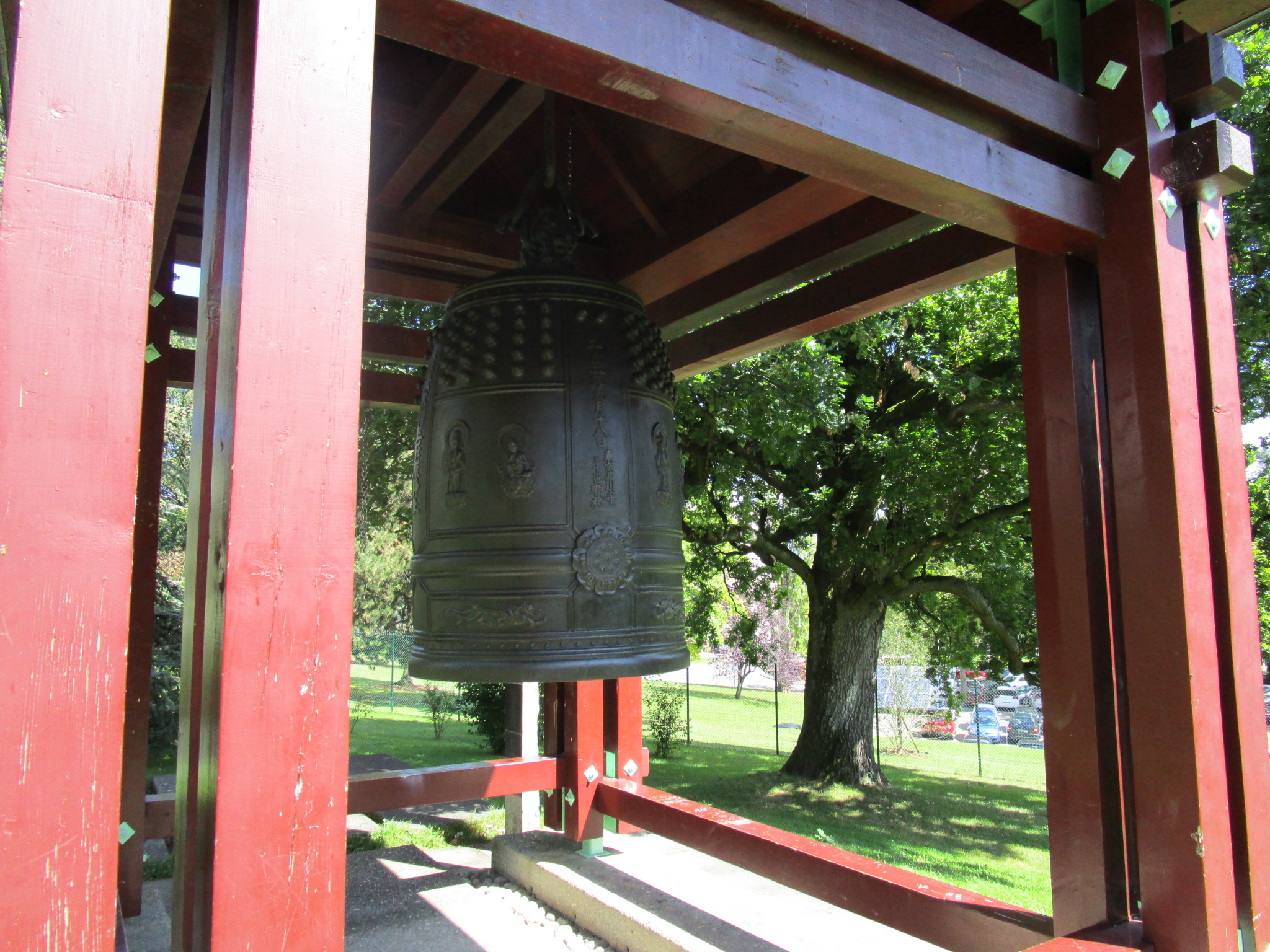 Inside is the Swiss Museum of Ceramics and Glass, but I really just went inside to be amazed by the decor. Other than the polite and welcoming staff, I think I was the only person in the building.
Inside is the Swiss Museum of Ceramics and Glass, but I really just went inside to be amazed by the decor. Other than the polite and welcoming staff, I think I was the only person in the building. Arriving at the United Nations proper, I found that I would not have time to properly tour the complex. A few snapshots would have to do.
Arriving at the United Nations proper, I found that I would not have time to properly tour the complex. A few snapshots would have to do. Across the street from the UN entrance, the monumental Broken Chair sculpture stands as a reminder to the politicians of the scourge or land mines and the horrors and lasting scars of war in general.
Across the street from the UN entrance, the monumental Broken Chair sculpture stands as a reminder to the politicians of the scourge or land mines and the horrors and lasting scars of war in general. Onwards, through the adjacent Botanical Gardens, which were truly great and resulted in lots of photos to show Sharon later. One memorable part was the educational but somewhat kooky display they had showing the various materials and substances that derive from the plant world — fibers, foodstuffs, pharmaceuticals. Hey, alliteration!
Onwards, through the adjacent Botanical Gardens, which were truly great and resulted in lots of photos to show Sharon later. One memorable part was the educational but somewhat kooky display they had showing the various materials and substances that derive from the plant world — fibers, foodstuffs, pharmaceuticals. Hey, alliteration!
 The Geneva transit system (free to tourists as I’ve mentioned) includes little ferry boats across the lake called “mouettes“, French for “gulls”. They’re not on a set schedule, rather just go back and forth all day, so you won’t wait more than 15 minutes or so for one. I boarded the next one and within 5-10 minutes was across the lake.
The Geneva transit system (free to tourists as I’ve mentioned) includes little ferry boats across the lake called “mouettes“, French for “gulls”. They’re not on a set schedule, rather just go back and forth all day, so you won’t wait more than 15 minutes or so for one. I boarded the next one and within 5-10 minutes was across the lake. … After getting a good look at the Jet d’Eau (“water jet”, duh). This water feature is out at the end of a jetty poking into the middle of the lake, and it’s huge. HUGE. Pumps at the base shoot the water 500 feet into the air, and depending on which way the wind is blowing, the water’s going to rain down on you. I decided the boat ride was close enough.
… After getting a good look at the Jet d’Eau (“water jet”, duh). This water feature is out at the end of a jetty poking into the middle of the lake, and it’s huge. HUGE. Pumps at the base shoot the water 500 feet into the air, and depending on which way the wind is blowing, the water’s going to rain down on you. I decided the boat ride was close enough. Making my way through the old city center, I toured the Saint Pierre Cathedral, a 12th century colossus with a steeple that you can climb up to and get a view of the city from. Actually, it’s not the steeple proper, rather one of the two adjacent towers. While I was snapping the pictures to make this panorama, the clock happened to strike 5pm and I was treated to the hourly (daily?) ringing of the chimes. Loud!
Making my way through the old city center, I toured the Saint Pierre Cathedral, a 12th century colossus with a steeple that you can climb up to and get a view of the city from. Actually, it’s not the steeple proper, rather one of the two adjacent towers. While I was snapping the pictures to make this panorama, the clock happened to strike 5pm and I was treated to the hourly (daily?) ringing of the chimes. Loud!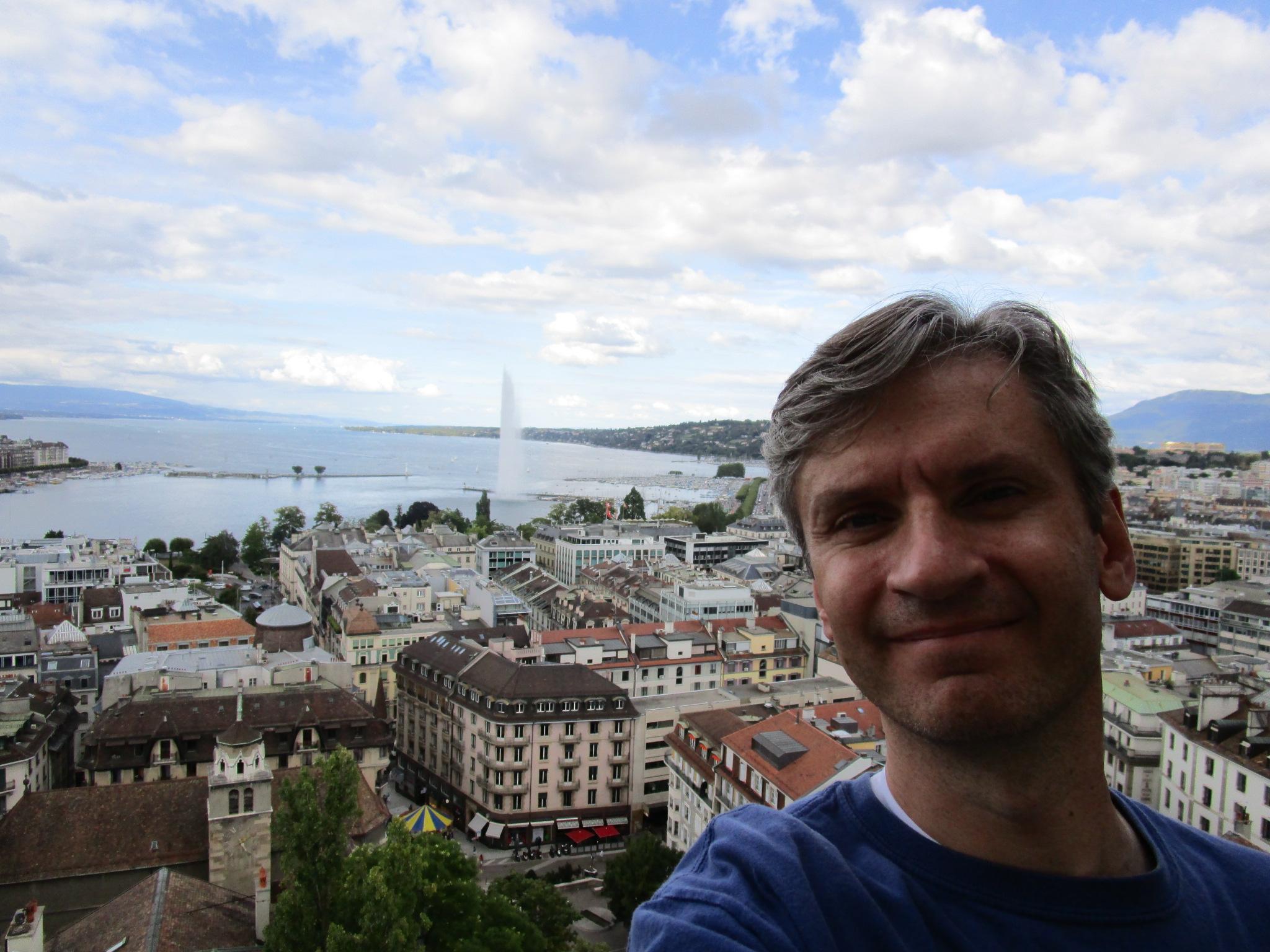 I spent quite a while up there, actually, taking pictures, visually wandering the city, and snapping a few photos of myself as proof of my existence in all this.
I spent quite a while up there, actually, taking pictures, visually wandering the city, and snapping a few photos of myself as proof of my existence in all this. As described in the previous post, I had managed to sweet-talk my way into another tour. This second tour would go to some other locations in the complex that I hadn’t seen.
As described in the previous post, I had managed to sweet-talk my way into another tour. This second tour would go to some other locations in the complex that I hadn’t seen.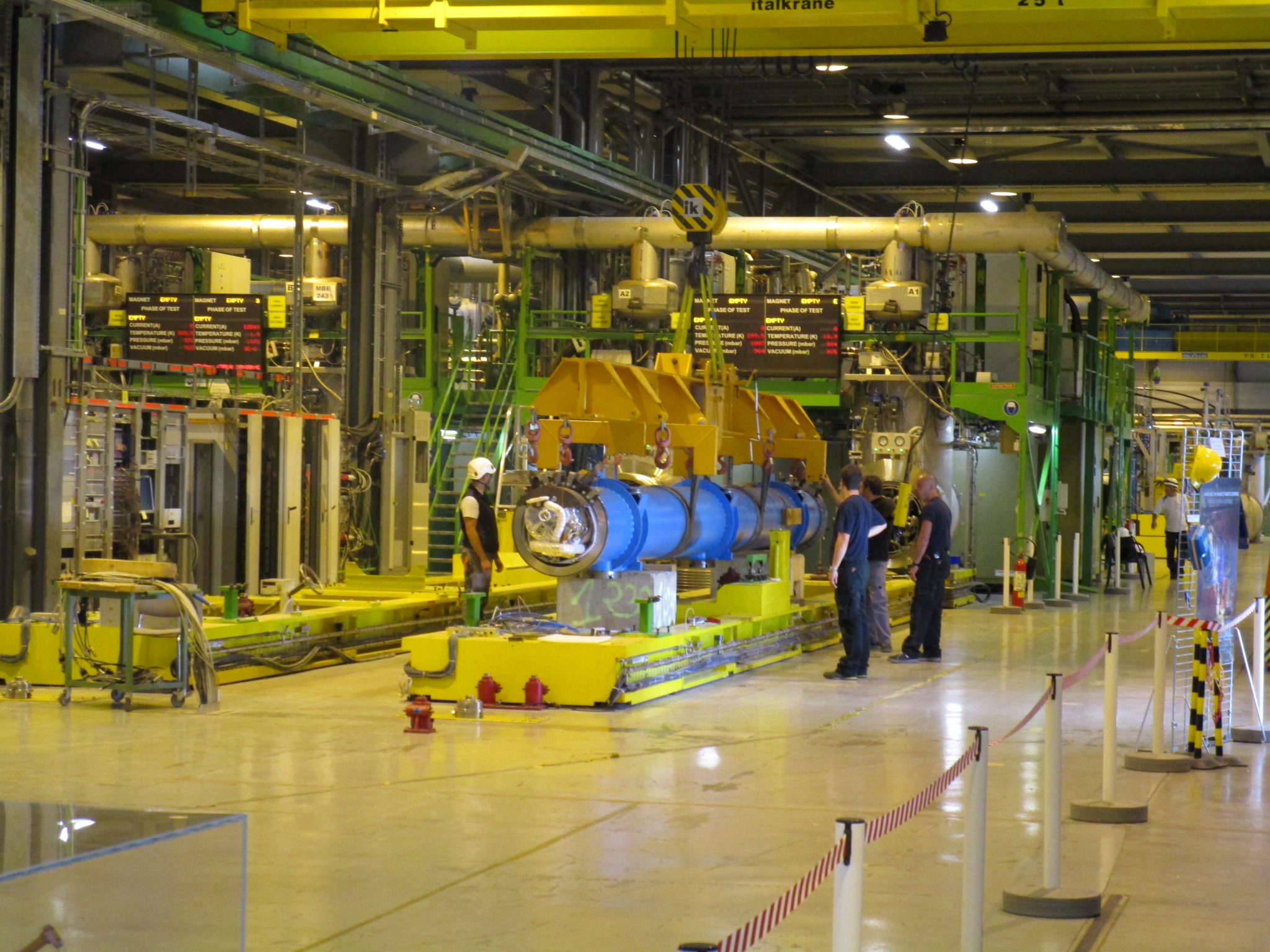 SM18 is the main testing facility for the magnets that are used in the LHC ring. I have no idea what “SM18” stands for — maybe “superconducting magnet” something. As I explained in the previous post, the accelerator ring uses extremely powerful magnets to bend the beam into a circle 27 km around. Even though the construction was completed in 2008, there are about 1600 magnet sections and there is bound to be repair and repalcement activity. This is especially true during a shutdown period such as 2013-2014, which is when they have their one chance to really take the thing apart and service it.
SM18 is the main testing facility for the magnets that are used in the LHC ring. I have no idea what “SM18” stands for — maybe “superconducting magnet” something. As I explained in the previous post, the accelerator ring uses extremely powerful magnets to bend the beam into a circle 27 km around. Even though the construction was completed in 2008, there are about 1600 magnet sections and there is bound to be repair and repalcement activity. This is especially true during a shutdown period such as 2013-2014, which is when they have their one chance to really take the thing apart and service it.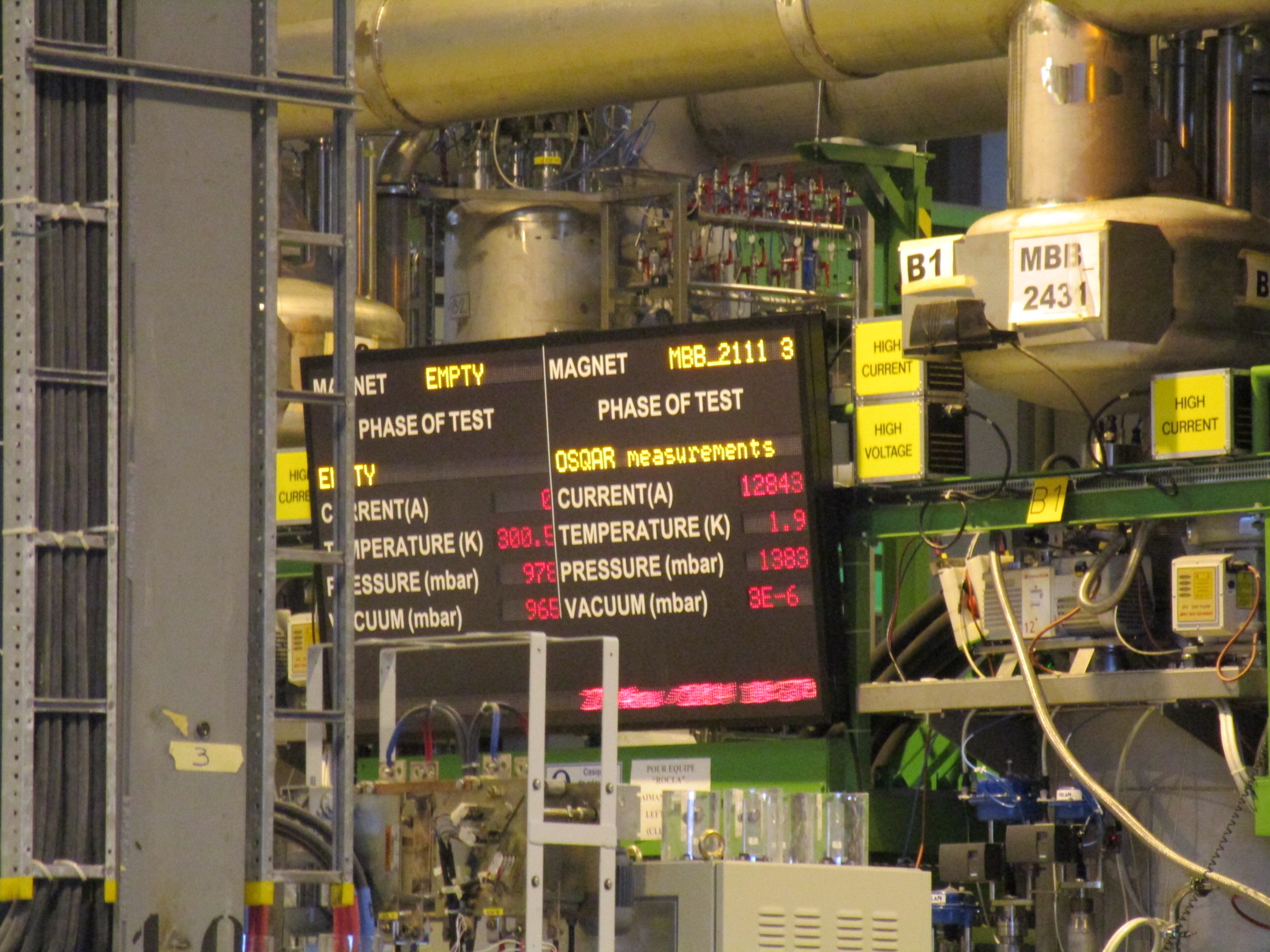 So what we got a glimpse of was a huge industrial space where they loaded in the dipole magnet sections, each about 15 meters long and weighing multiple tons, and ran them through a series of tests. I can’t tell you how excited I was to see them actually moving the sections around, actually testing them, showing actual results on the large aerial displays. If you look closely at the numbers in this picture, on the display you will see:
So what we got a glimpse of was a huge industrial space where they loaded in the dipole magnet sections, each about 15 meters long and weighing multiple tons, and ran them through a series of tests. I can’t tell you how excited I was to see them actually moving the sections around, actually testing them, showing actual results on the large aerial displays. If you look closely at the numbers in this picture, on the display you will see: We were only allowed into a little corner of the building, but they had all sorts of cool models and hardware on display for us. Models of the building with little trucks showing how gear moved in and out. Models of the tube with all of the magnets and superconducting wires packed around it. Various hardware like an actual dipole section with the side cut out of it so you could get a view of the innrds. A cryogenic valve. Dipole magnets, quadrupole magnets, sextupole magnets, oh my!
We were only allowed into a little corner of the building, but they had all sorts of cool models and hardware on display for us. Models of the building with little trucks showing how gear moved in and out. Models of the tube with all of the magnets and superconducting wires packed around it. Various hardware like an actual dipole section with the side cut out of it so you could get a view of the innrds. A cryogenic valve. Dipole magnets, quadrupole magnets, sextupole magnets, oh my!  Back onto the bus and onwards through the French / Swiss countryside, with beautiful views of the Jura mountains.
Back onto the bus and onwards through the French / Swiss countryside, with beautiful views of the Jura mountains. However CMS is contained within a gigantic cavern, much bigger than LHCb’s — only the ATLAS cavern matches it in size. And ATLAS was already sealed up getting ready for operations, so CMS would be my one chance to see one of the big LHC experiments.
However CMS is contained within a gigantic cavern, much bigger than LHCb’s — only the ATLAS cavern matches it in size. And ATLAS was already sealed up getting ready for operations, so CMS would be my one chance to see one of the big LHC experiments. First they showed us around the surface level buildings, which contain various support items like cranes, gas storage tanks, air chillers, etc., but all on a very large scale.
First they showed us around the surface level buildings, which contain various support items like cranes, gas storage tanks, air chillers, etc., but all on a very large scale. I don’t even remember the distance now, but I did grab this snapshot looking UP the main access shaft to the surface. That bore was some 60 feet wide, originally sized to lower the gargantuan experiment components down to the cavern, but once they finished loading down the big items, they filled in the shaft with various other infrastructure — like a couple proper elevators, ventilation, and so forth.
I don’t even remember the distance now, but I did grab this snapshot looking UP the main access shaft to the surface. That bore was some 60 feet wide, originally sized to lower the gargantuan experiment components down to the cavern, but once they finished loading down the big items, they filled in the shaft with various other infrastructure — like a couple proper elevators, ventilation, and so forth. As we worked our way closer to the cavern, we passed room after room of support equipment. Not everything has to be located right inside the experiment area proper, but it also can’t be located too far away (like at the surface), because then the computer communications would slow down. They are dealing with massive amounts of data, literally the highest data flows on the planet, and in those applications the distance the communications has to travel is a factor.
As we worked our way closer to the cavern, we passed room after room of support equipment. Not everything has to be located right inside the experiment area proper, but it also can’t be located too far away (like at the surface), because then the computer communications would slow down. They are dealing with massive amounts of data, literally the highest data flows on the planet, and in those applications the distance the communications has to travel is a factor.
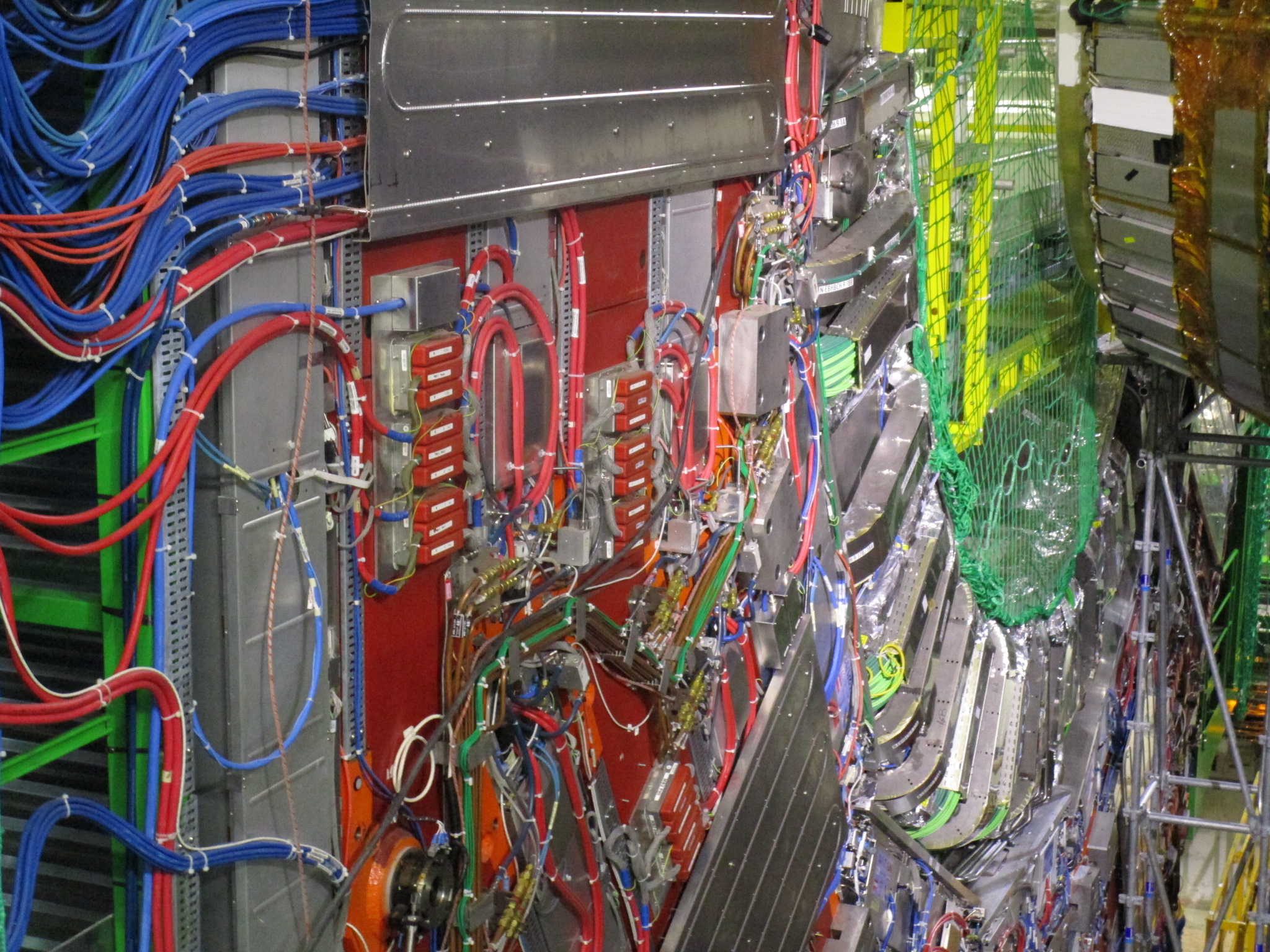 The picture above is of the center of the CMS experiment. When the LHC is operating, one beam crosses from left to right, and another one in the opposite direction, and they collider along the axis in the center. Surrounding that collision point is meters and tons of electronics to detect the various particles that spray away from the center. Pictured at right is a just a detail of part of the machine; click it to embiggen.
The picture above is of the center of the CMS experiment. When the LHC is operating, one beam crosses from left to right, and another one in the opposite direction, and they collider along the axis in the center. Surrounding that collision point is meters and tons of electronics to detect the various particles that spray away from the center. Pictured at right is a just a detail of part of the machine; click it to embiggen.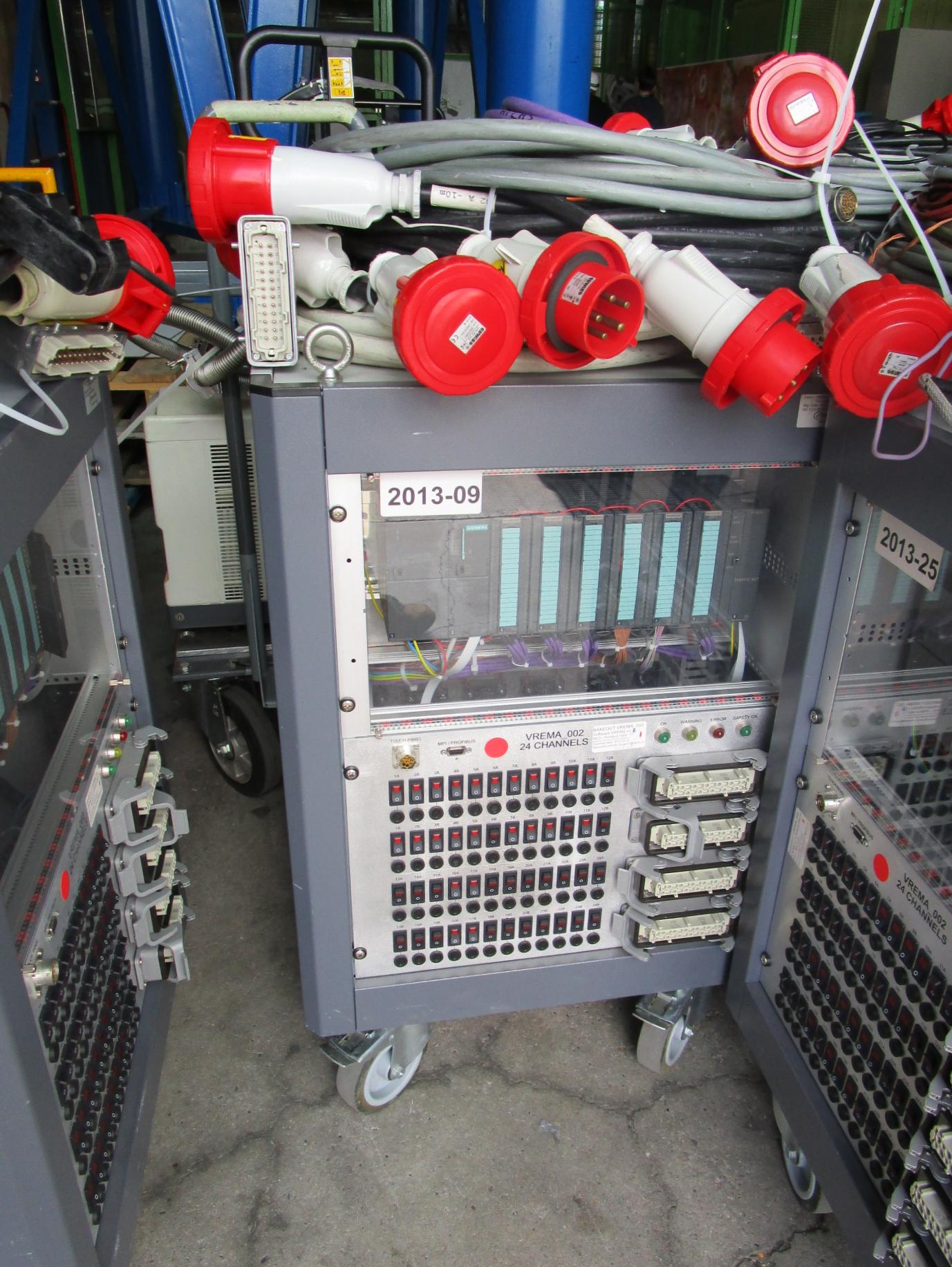 Aaand back up to the surface! Off in a corner I noticed some gear on carts, looked like data acquisition equipment. I just thought the connector were interesting — the big round ones are European-standard high power connectors, and the rectangular ones to the left are Amphenol parallel data connectors.
Aaand back up to the surface! Off in a corner I noticed some gear on carts, looked like data acquisition equipment. I just thought the connector were interesting — the big round ones are European-standard high power connectors, and the rectangular ones to the left are Amphenol parallel data connectors.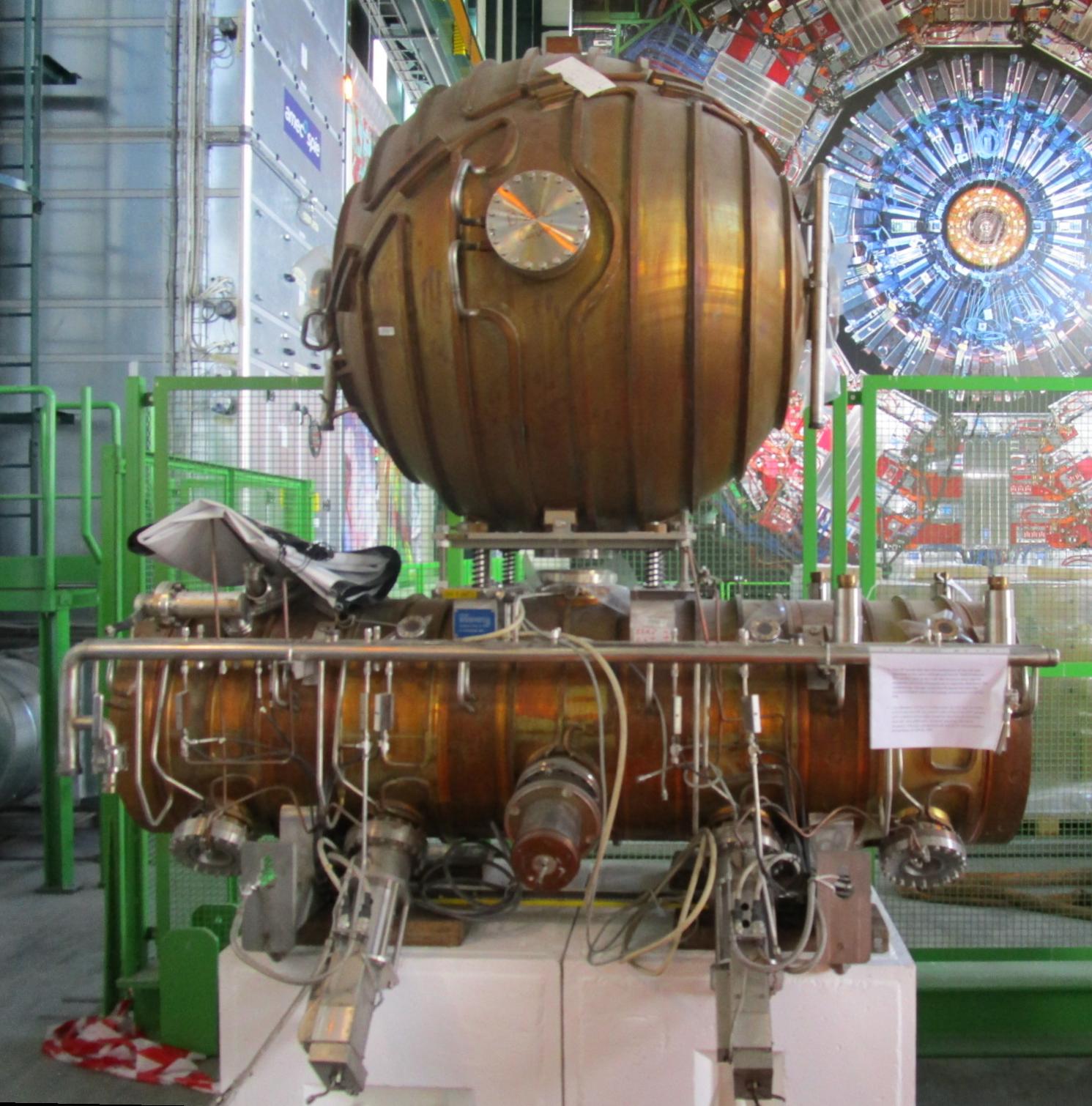 At the surface level, where they have a bit more room to spare, they have a few displays set up, such as this item reminiscent perhaps of a Jules Verne story, but actually an RF energy storage cavity for the old
At the surface level, where they have a bit more room to spare, they have a few displays set up, such as this item reminiscent perhaps of a Jules Verne story, but actually an RF energy storage cavity for the old  The assembly hall at the surface was sized big enough to put together the major components of the experiment, which were then lowered through the access shaft. This picture shows the end of the hall with a gigantic life-sized picture of one of the components, before it was lowered, showing how it did literally barely fit in the hall (and the shaft, and the cavern).
The assembly hall at the surface was sized big enough to put together the major components of the experiment, which were then lowered through the access shaft. This picture shows the end of the hall with a gigantic life-sized picture of one of the components, before it was lowered, showing how it did literally barely fit in the hall (and the shaft, and the cavern). Our last stop at the CMS complex was to visit a modest exhibition they had set up showing the various components. Here you could get up close and personal with the parts. In this picture you can see the scale of the superconducting magnets at the very center of the beam.
Our last stop at the CMS complex was to visit a modest exhibition they had set up showing the various components. Here you could get up close and personal with the parts. In this picture you can see the scale of the superconducting magnets at the very center of the beam. At long last, the day had come: I was going to visit CERN. For 50 years, the
At long last, the day had come: I was going to visit CERN. For 50 years, the  From the 1950s through the 1980s, CERN operated a series of accelerators, starting with a 600 MeV ring and ending with a 62 GeV system. The “eV” in there stand for “
From the 1950s through the 1980s, CERN operated a series of accelerators, starting with a 600 MeV ring and ending with a 62 GeV system. The “eV” in there stand for “ In 1989, CERN started up the
In 1989, CERN started up the  In 2000, after years of planning, they shut down the LEP and started dismantling it. In its place, in the same tunnel, they would build the
In 2000, after years of planning, they shut down the LEP and started dismantling it. In its place, in the same tunnel, they would build the  The United States had planned to build a similar particle accelerator on the same principles, but one that would have utterly dwarfed even today’s LHC. It was called the
The United States had planned to build a similar particle accelerator on the same principles, but one that would have utterly dwarfed even today’s LHC. It was called the  I should mention that it’s not just the “eV” power of the accelerator that matters. How those beams get focused, and how the data gets analyzed, are also crucial performance issues that drive how productive an accelerator is.
I should mention that it’s not just the “eV” power of the accelerator that matters. How those beams get focused, and how the data gets analyzed, are also crucial performance issues that drive how productive an accelerator is. The public face of the CERN complex is a surprisingly modest visitors center, but it hides a large museum, containing seemingly every artifact of 50 years of exploration at the smallest scales. Hardware of all shapes and sizes, displays and movies that explain what they do, examples of how computer storage worked back in the day … In a courtyard that we couldn’t get to, but could see through the windows, they had all sorts of impossibly exotic gear mounted and displayed, literally put out to pasture outside. Signs, signs, I have to read the signs!
The public face of the CERN complex is a surprisingly modest visitors center, but it hides a large museum, containing seemingly every artifact of 50 years of exploration at the smallest scales. Hardware of all shapes and sizes, displays and movies that explain what they do, examples of how computer storage worked back in the day … In a courtyard that we couldn’t get to, but could see through the windows, they had all sorts of impossibly exotic gear mounted and displayed, literally put out to pasture outside. Signs, signs, I have to read the signs! Being able to see the tunnel was actually quite a unique opportunity. As a high energy physics experiment, when the beams are running, it’s quite radioactive in the tunnel, and nobody is allowed in there, not even workers. Like a nuclear power plant, everyone clears out of the tunnel and they seal the doors before starting the sequence to fire up the machine. Well, 2013-2014 was a major period or planned downtime, when they would be really shutting the machine down, and basically taking it apart and refurbishing it. So during that extended downtime, they were letting the public get even closer to the equipment than they normally would. However, the shutdown was coming to an end, and some parts of the tunnel were already off limits to even CERN workers. This timing is why I made the effort in the first place to get to Geneva on this trip.
Being able to see the tunnel was actually quite a unique opportunity. As a high energy physics experiment, when the beams are running, it’s quite radioactive in the tunnel, and nobody is allowed in there, not even workers. Like a nuclear power plant, everyone clears out of the tunnel and they seal the doors before starting the sequence to fire up the machine. Well, 2013-2014 was a major period or planned downtime, when they would be really shutting the machine down, and basically taking it apart and refurbishing it. So during that extended downtime, they were letting the public get even closer to the equipment than they normally would. However, the shutdown was coming to an end, and some parts of the tunnel were already off limits to even CERN workers. This timing is why I made the effort in the first place to get to Geneva on this trip. The CERN folks corralled us onto a bus and we headed off into the Swiss countryside. Well, actually, the French countryside, because right after pulling out of the parking lot, we crossed the Swiss-French border. There hasn’t been any border control in most of Europe since the Schengen Area was agreed to in the mid-90s, which the Swiss finally joined in 2008. So there are all these abandoned border posts, and we just drove right through it.
The CERN folks corralled us onto a bus and we headed off into the Swiss countryside. Well, actually, the French countryside, because right after pulling out of the parking lot, we crossed the Swiss-French border. There hasn’t been any border control in most of Europe since the Schengen Area was agreed to in the mid-90s, which the Swiss finally joined in 2008. So there are all these abandoned border posts, and we just drove right through it. Our first stop would be the LHCb. At each of four points around the 17-mile ring, CERN built a massive underground cavern around the precise spot where they would collide the beams. With a 7 TeV beam going in one direction around the ring, and a 7 TeV beam going the other direction, they would have 14 TeV collision energies, and the cavern was built to house the colossal machinery that would be needed to detect and measure the sub-atomic bits that came flying off. The “
Our first stop would be the LHCb. At each of four points around the 17-mile ring, CERN built a massive underground cavern around the precise spot where they would collide the beams. With a 7 TeV beam going in one direction around the ring, and a 7 TeV beam going the other direction, they would have 14 TeV collision energies, and the cavern was built to house the colossal machinery that would be needed to detect and measure the sub-atomic bits that came flying off. The “ Our tour guide was a young Polish physicist named Agnieszka, and she led us first through the small displays they had set up in a waiting area at the surface level. The bulk of the machinery was below us, but they still need a hall at the surface to stage material and raise from / lower to the tunnel. Also up here was the main control room, unmanned because of the long-term shutdown, but which would be humming again soon enough.
Our tour guide was a young Polish physicist named Agnieszka, and she led us first through the small displays they had set up in a waiting area at the surface level. The bulk of the machinery was below us, but they still need a hall at the surface to stage material and raise from / lower to the tunnel. Also up here was the main control room, unmanned because of the long-term shutdown, but which would be humming again soon enough. Right about this point is where I realized something horrible: my battery camera was almost dead. I had obviously been planning the logistics of this visit for a very long time, and I had packed extra camera batteries and made sure to charged them up. But I had left them at the hotel! Oh shiiiiiiiiit. I was about to into the CERN tunnel, and my camera would be dead!
Right about this point is where I realized something horrible: my battery camera was almost dead. I had obviously been planning the logistics of this visit for a very long time, and I had packed extra camera batteries and made sure to charged them up. But I had left them at the hotel! Oh shiiiiiiiiit. I was about to into the CERN tunnel, and my camera would be dead! Agnieszka handed us off to her colleague (and fellow Pole) Rafal, who would take us down to the tunnel. They handed us all hardhats (color coded to our tour group) and had us go through the security checkpoint. This was basically a fancier version of what you go through at the airport, or what I used to do when working in nuclear power plants.
Agnieszka handed us off to her colleague (and fellow Pole) Rafal, who would take us down to the tunnel. They handed us all hardhats (color coded to our tour group) and had us go through the security checkpoint. This was basically a fancier version of what you go through at the airport, or what I used to do when working in nuclear power plants. ad scanned through, we got into a freight elevator and went down.
ad scanned through, we got into a freight elevator and went down. eet high, with metal lattice work forming multiple levels (stories) for workers to use to access equipment. Our first stop was in a side section of the cavern containing a monstrous instrument left over from the LEP days. This same cavern had been used in the LEP, and when they dismantled that system and started building the LHC, they had room in this cavern to just shove this instrument off to the side. Since it obviously had been decommissioned, we were allowed to get up close and personal with it.
eet high, with metal lattice work forming multiple levels (stories) for workers to use to access equipment. Our first stop was in a side section of the cavern containing a monstrous instrument left over from the LEP days. This same cavern had been used in the LEP, and when they dismantled that system and started building the LHC, they had room in this cavern to just shove this instrument off to the side. Since it obviously had been decommissioned, we were allowed to get up close and personal with it.
 y and (cue angelic choirs) the LHCb experiment! This machine was basically a horizontal stack of vertical layers. The beam would come in from the right, the collision would occur in the right side of the cavern, and the particles would spray off to the left, through all those detector layers. If you scrutinize the smaller LHCb photo above, you will see a man wearing a yellow hardhat. Go to the upper left corner of the blue and white “LHCb” sign, go to the left past the white circle with the red object in the center, and just to the left
y and (cue angelic choirs) the LHCb experiment! This machine was basically a horizontal stack of vertical layers. The beam would come in from the right, the collision would occur in the right side of the cavern, and the particles would spray off to the left, through all those detector layers. If you scrutinize the smaller LHCb photo above, you will see a man wearing a yellow hardhat. Go to the upper left corner of the blue and white “LHCb” sign, go to the left past the white circle with the red object in the center, and just to the left of that you’ll see him.
of that you’ll see him. oster of the women working on LHCb. Girl Power! Also, note the Comic Sans, which is a bit of
oster of the women working on LHCb. Girl Power! Also, note the Comic Sans, which is a bit of  “border”, back to the visitor’s center.
“border”, back to the visitor’s center. he gift store! The store was tiny (by US standards) but chock full of the most incredible books and science tchotchkes. I literally would have bought everything in the store, but everything was going to eventually need to fit into my suitcase, and later in this same trip I’d be lugging this suitcase onto a sailboat … So I bought some more compact items, took pictures of the bulkier items for future wishlist purposes, and headed back to the hotel.
he gift store! The store was tiny (by US standards) but chock full of the most incredible books and science tchotchkes. I literally would have bought everything in the store, but everything was going to eventually need to fit into my suitcase, and later in this same trip I’d be lugging this suitcase onto a sailboat … So I bought some more compact items, took pictures of the bulkier items for future wishlist purposes, and headed back to the hotel. After resting at the hotel for a bit, and soaking up some internet, I struck out on an evening jaunt. One of the first high-power EV charging stations had supposedly been installed in a suburb just west of Geneva. The streetcars didn’t run out there, but the busses did. So, in the failing light of mid-evening, I literally got off a bus in the middle of some strange residential neighborhood and hunted around for this charging station. Walked up and down little alleyways, through parking lots, all over the place. In the end, the charging station was located a good bit away from the map marker I was chasing — at a Volkswagen dealership, duh. But I found it!
After resting at the hotel for a bit, and soaking up some internet, I struck out on an evening jaunt. One of the first high-power EV charging stations had supposedly been installed in a suburb just west of Geneva. The streetcars didn’t run out there, but the busses did. So, in the failing light of mid-evening, I literally got off a bus in the middle of some strange residential neighborhood and hunted around for this charging station. Walked up and down little alleyways, through parking lots, all over the place. In the end, the charging station was located a good bit away from the map marker I was chasing — at a Volkswagen dealership, duh. But I found it!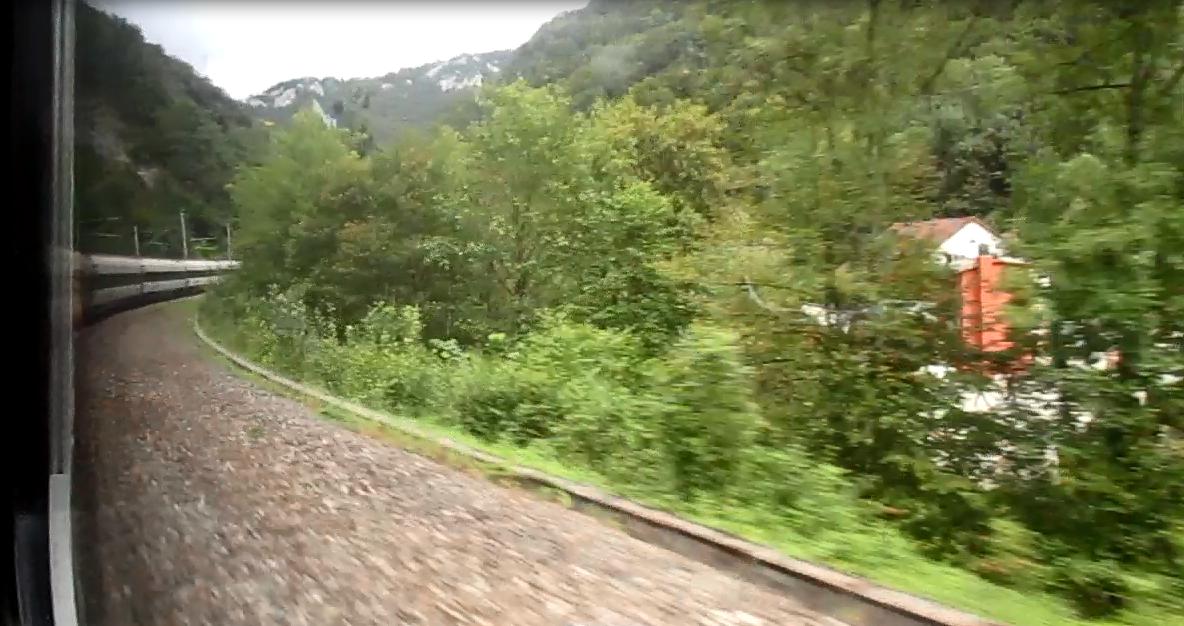 Next stop, two hours later, was the Swiss city of Basel, just over the border from Germany.
Next stop, two hours later, was the Swiss city of Basel, just over the border from Germany. One more train change and I was finally on the last leg to Geneva. For the last half hour or so, we rode along the north shore of Lake Geneva, and the good weather provided for impossibly beautiful views out the window.
One more train change and I was finally on the last leg to Geneva. For the last half hour or so, we rode along the north shore of Lake Geneva, and the good weather provided for impossibly beautiful views out the window.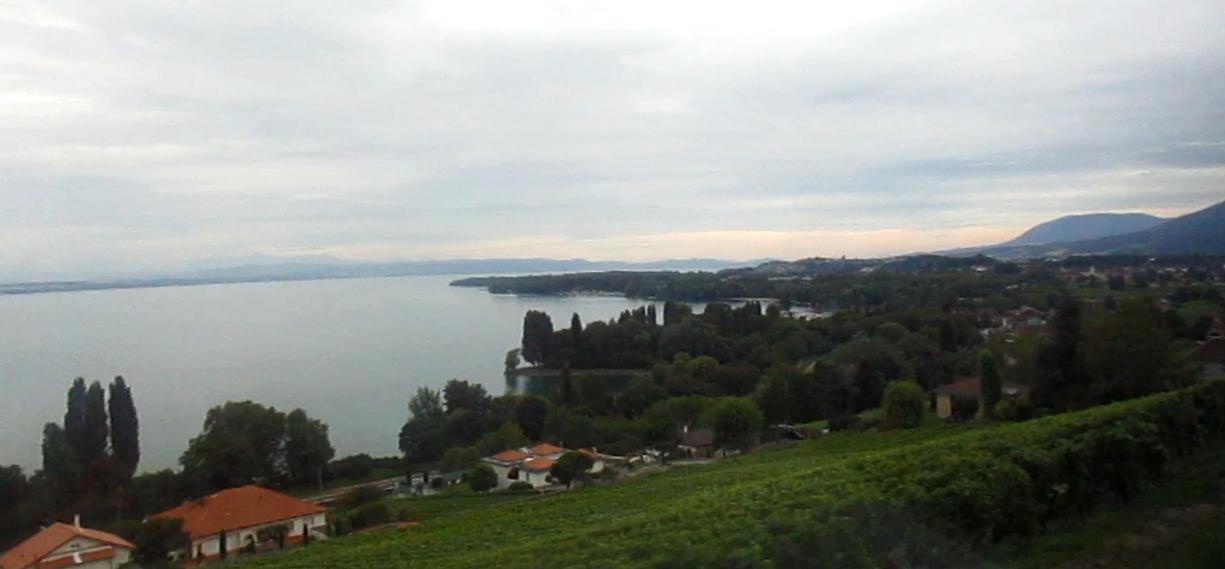 Which leads to another thing: the Swiss have not signed onto the Euro currency used nearly everywhere in Europe (insert monetary policy explanations here), instead sticking with their own Swiss Franc (CHF) currency. Stores will take Euros, but you’ll get your change back in CHF, which has a different exchange rate. Take that pile of strange coins in your hand, and couple that with the language barrier, and I suspect they routinely fudge the conversion numbers in their favor when giving you change. Geneva is already a very expensive city, and this only exacerbates it. Oh well.
Which leads to another thing: the Swiss have not signed onto the Euro currency used nearly everywhere in Europe (insert monetary policy explanations here), instead sticking with their own Swiss Franc (CHF) currency. Stores will take Euros, but you’ll get your change back in CHF, which has a different exchange rate. Take that pile of strange coins in your hand, and couple that with the language barrier, and I suspect they routinely fudge the conversion numbers in their favor when giving you change. Geneva is already a very expensive city, and this only exacerbates it. Oh well.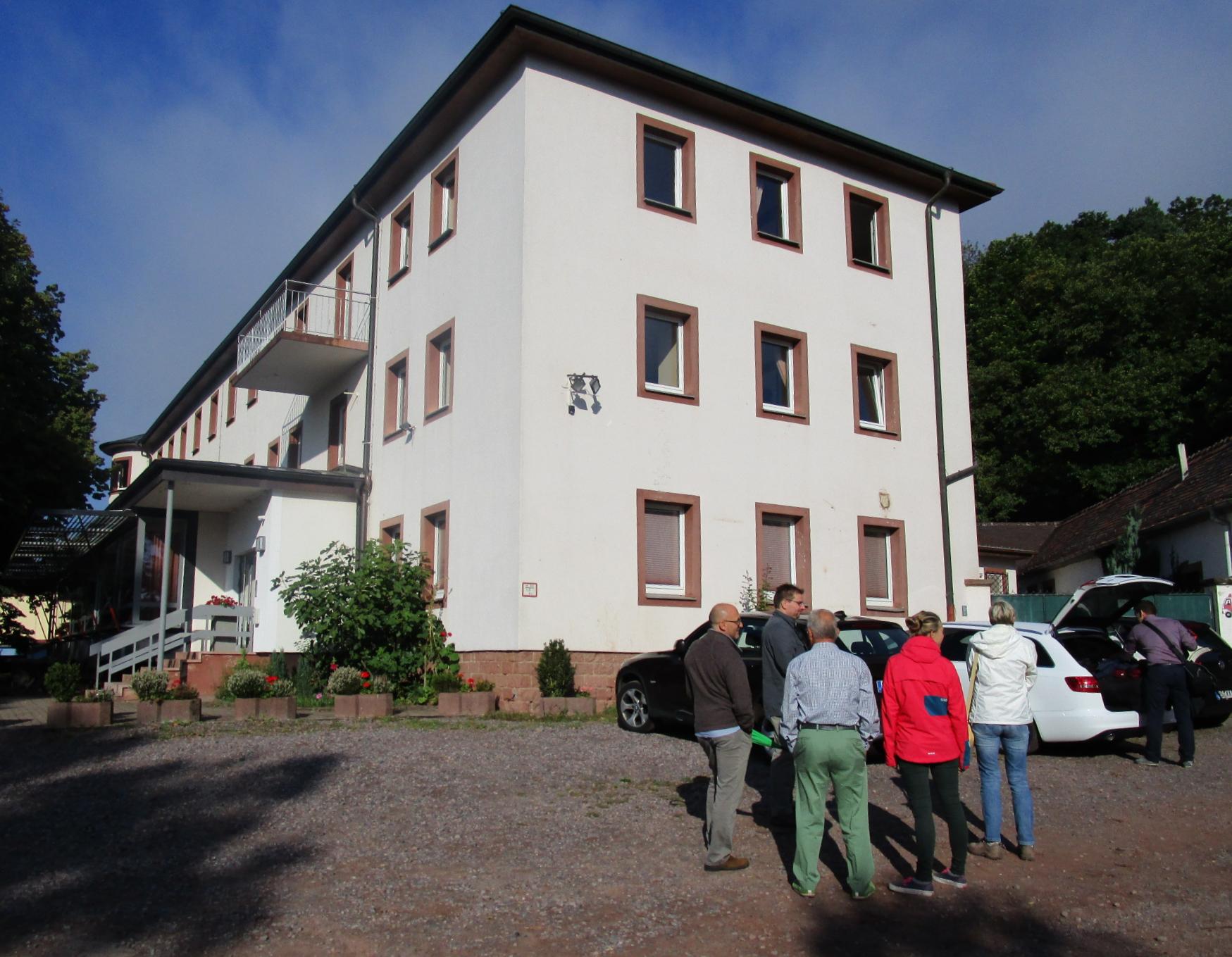 I survived the rough night and had a nice breakfast with the extended family in the hostel’s cafeteria. Actually, I took it easy on the breakfast, just sampling crackers etc., which was a shame since it was a typically luxurious German spread of meats and cheeses.
I survived the rough night and had a nice breakfast with the extended family in the hostel’s cafeteria. Actually, I took it easy on the breakfast, just sampling crackers etc., which was a shame since it was a typically luxurious German spread of meats and cheeses.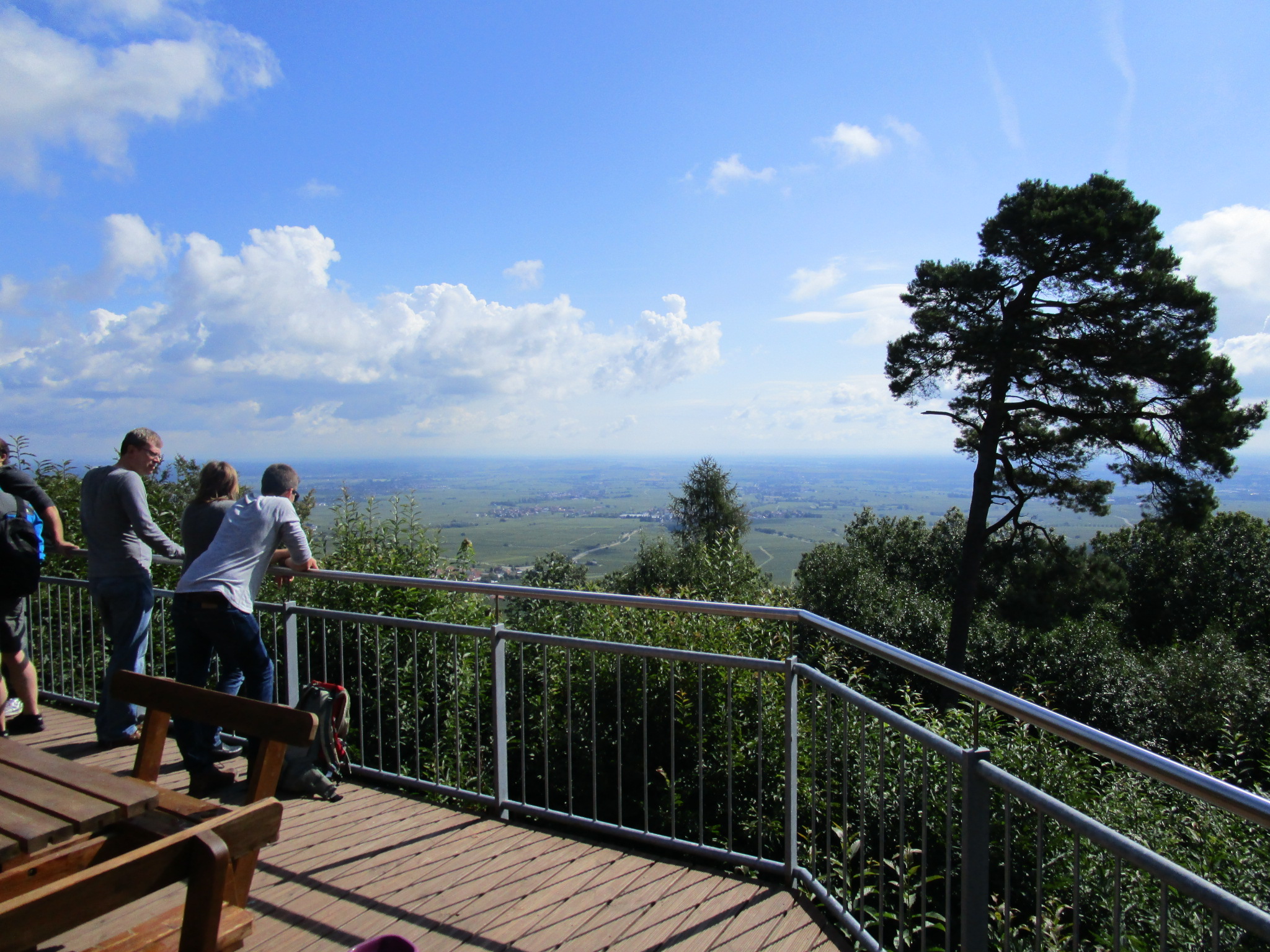 We gathered up the herd outside the hostel, took a few last pictures of the Trifels in the distance, and loaded up into the vehicles. Stefan’s planned activity for us this morning was to hike up the Ringelsberg, a small mountain nearby, which had
We gathered up the herd outside the hostel, took a few last pictures of the Trifels in the distance, and loaded up into the vehicles. Stefan’s planned activity for us this morning was to hike up the Ringelsberg, a small mountain nearby, which had 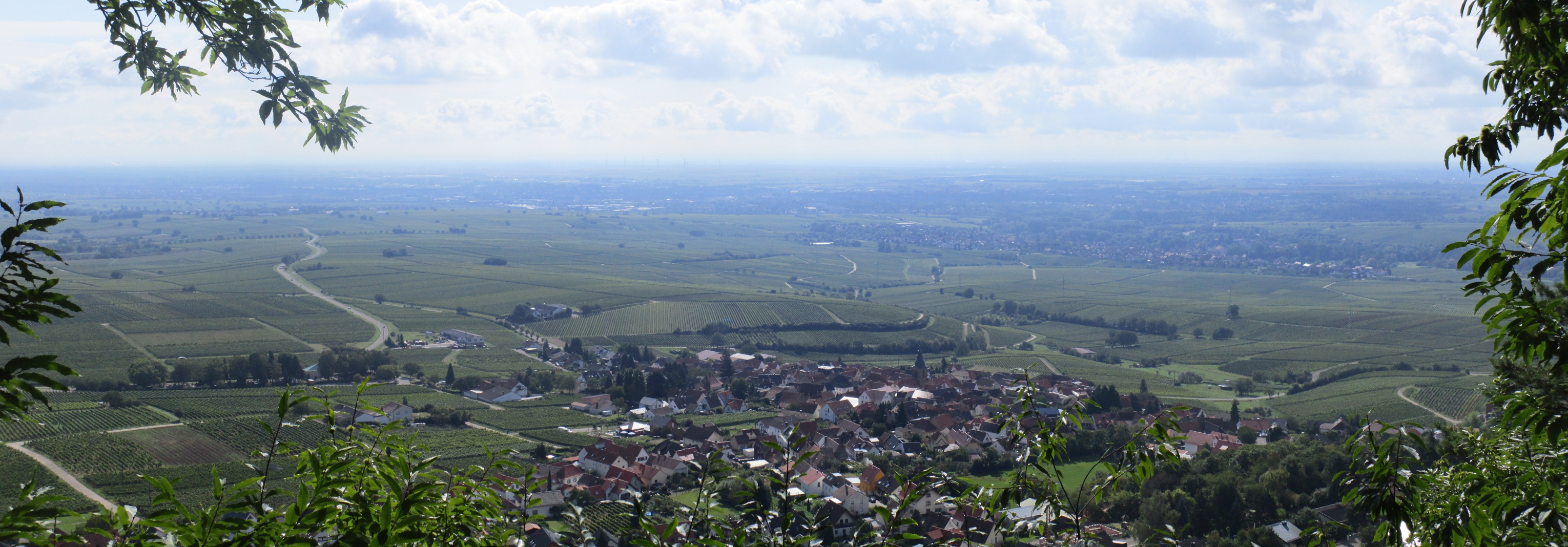
 If they’re not going on a long roadtrip somewhere, they’d rather just bike it or even walk it. Appropriately, the family business is a busy bike shop in central Heidelberg.
If they’re not going on a long roadtrip somewhere, they’d rather just bike it or even walk it. Appropriately, the family business is a busy bike shop in central Heidelberg. So, naturally, upon arrival in at their Heidelberg house (greeted by cat), we had a snack and then promptly set out on a hike around the neighborhood. The city of Heidelberg is on the Neckar River, nestled between two ridges, one of which climbs up behind their house. So we hiked all around, starting with a visit to a property a few minutes away that Susann and Peter would be building a new house on .
So, naturally, upon arrival in at their Heidelberg house (greeted by cat), we had a snack and then promptly set out on a hike around the neighborhood. The city of Heidelberg is on the Neckar River, nestled between two ridges, one of which climbs up behind their house. So we hiked all around, starting with a visit to a property a few minutes away that Susann and Peter would be building a new house on . 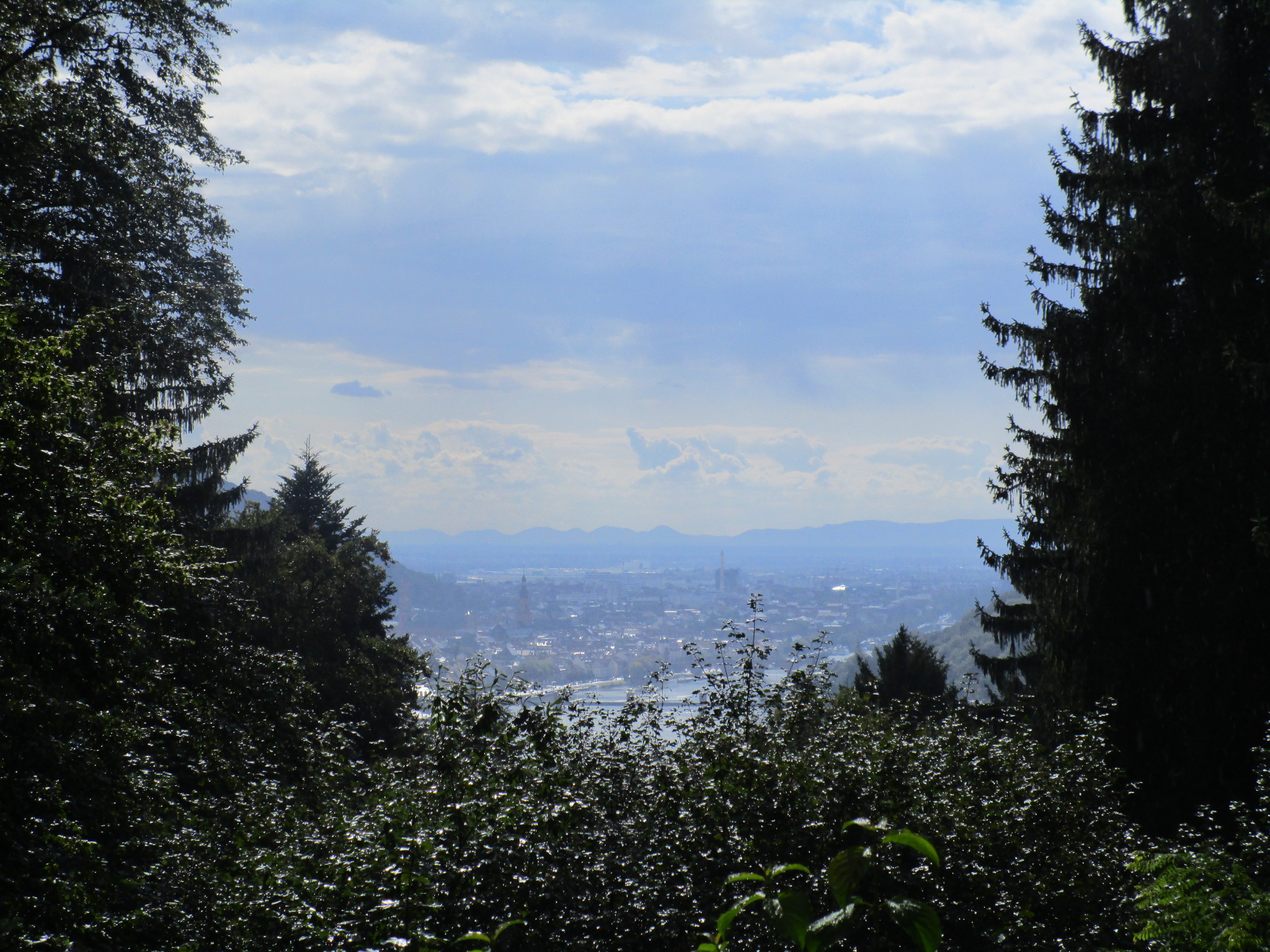 Continuing, we went up to the top of the ridge for a view, down past an old monastery, along the river, and generally had a great afternoon exploring.
Continuing, we went up to the top of the ridge for a view, down past an old monastery, along the river, and generally had a great afternoon exploring.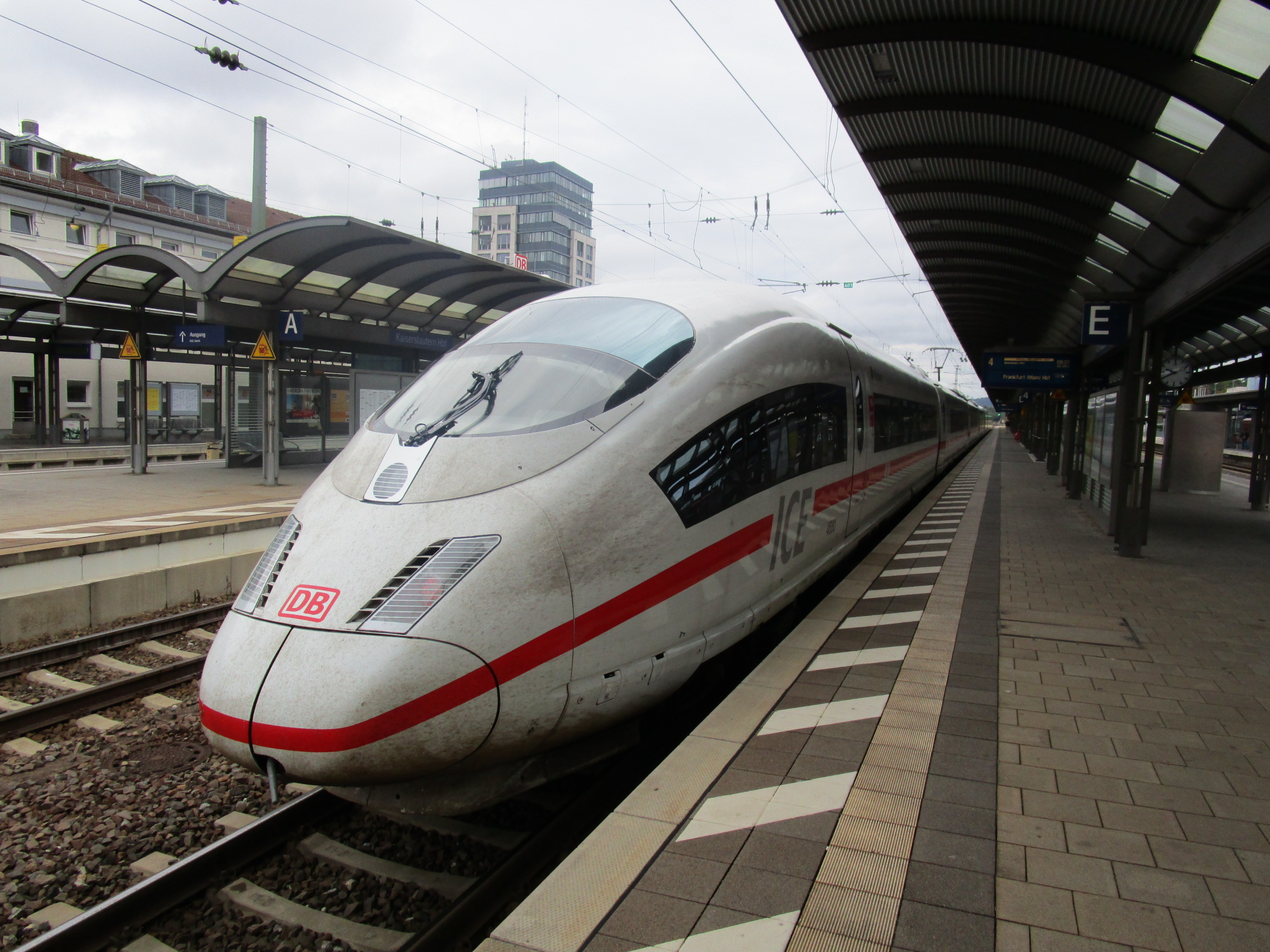 Booking a train that departed at 6am wasn’t going to be a problem for me, since I was going to be jetlagged and up by 5am anyway …
Booking a train that departed at 6am wasn’t going to be a problem for me, since I was going to be jetlagged and up by 5am anyway … Annweiler is a small town in southwestern Germany, very close to the French border, where my mother’s side of the family hails from. As a child of age 14, I lived in Annweiler with
Annweiler is a small town in southwestern Germany, very close to the French border, where my mother’s side of the family hails from. As a child of age 14, I lived in Annweiler with  The extended family was gathering in Annweiler to celebrate my cousin Stefan’s 50th birthday. Stefan is the oldest of our generation — altogether there were (counts on fingers) nine of us born between 1963 and 1980, in two waves, as each of the three Conrad daughters had three children. Besides our generation, the older generation was fully represented, as was the younger generation, including the two latest additions Theodor and Lukas. I was the sole representation for the American arm of the family.
The extended family was gathering in Annweiler to celebrate my cousin Stefan’s 50th birthday. Stefan is the oldest of our generation — altogether there were (counts on fingers) nine of us born between 1963 and 1980, in two waves, as each of the three Conrad daughters had three children. Besides our generation, the older generation was fully represented, as was the younger generation, including the two latest additions Theodor and Lukas. I was the sole representation for the American arm of the family.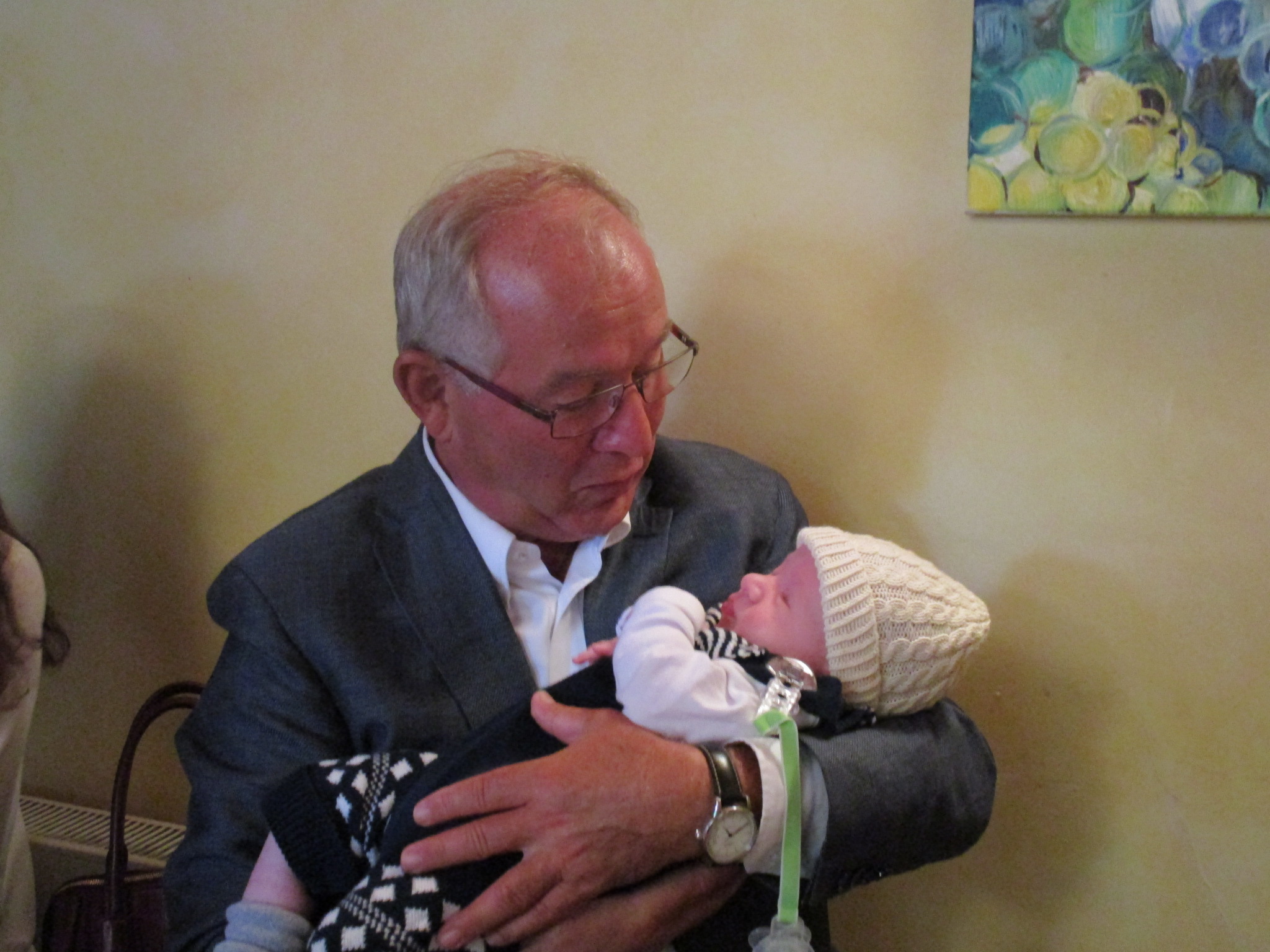 My first stop in Annweiler was to visit with Günther Frey. Günther is a longtime family friend, and by longtime I mean like over 50 years. He group with my mom and her sisters, and his wife Herma was my mom’s best friend growing up. Sadly Herma passed away a couple years ago. Renate joined me in visiting with Günther, which was very helpful because my German is always very weak at the beginning of these trips, and so she helped translate as needed. Günther looks to be in great health and it was amazing to visit the Frey household (one that I’d been in as a teenager) and catchup on the status of his children Anja, Klaus and Ulrike, now all grown and with kids of their own.
My first stop in Annweiler was to visit with Günther Frey. Günther is a longtime family friend, and by longtime I mean like over 50 years. He group with my mom and her sisters, and his wife Herma was my mom’s best friend growing up. Sadly Herma passed away a couple years ago. Renate joined me in visiting with Günther, which was very helpful because my German is always very weak at the beginning of these trips, and so she helped translate as needed. Günther looks to be in great health and it was amazing to visit the Frey household (one that I’d been in as a teenager) and catchup on the status of his children Anja, Klaus and Ulrike, now all grown and with kids of their own.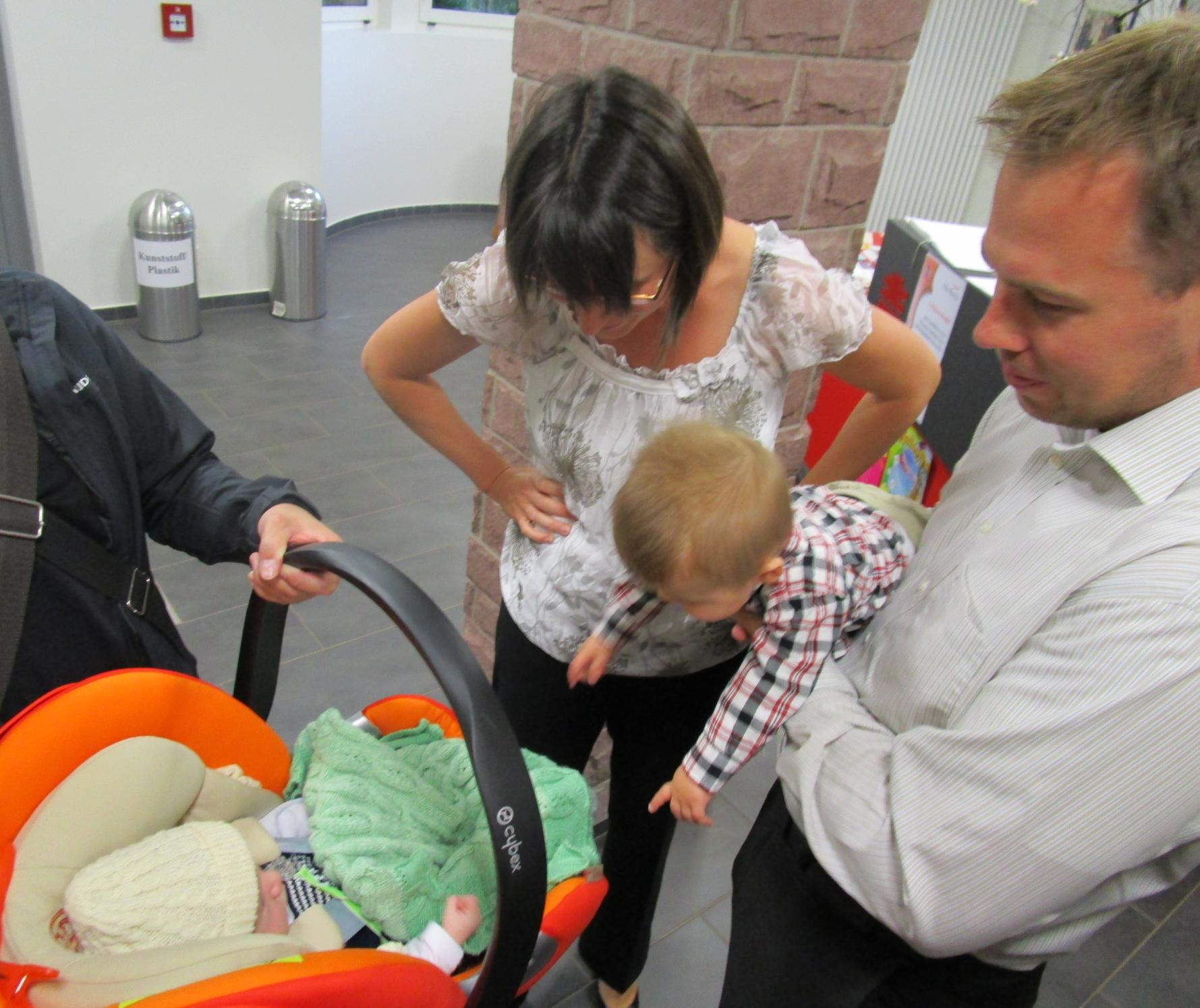 After parting with Günther, Renate and I met up with the whole family at a restaurant in the town center. After a bit of hanging out and snacking, we split up into various cars and headed out to a winery, where an afternoon tasting event had been planned. It’s just amazing to be driving through the heart of wine country in August, just before the harvest, seeing mile after mile of neat rows of grapevines flitter past. At the winery,
After parting with Günther, Renate and I met up with the whole family at a restaurant in the town center. After a bit of hanging out and snacking, we split up into various cars and headed out to a winery, where an afternoon tasting event had been planned. It’s just amazing to be driving through the heart of wine country in August, just before the harvest, seeing mile after mile of neat rows of grapevines flitter past. At the winery,  After the winery, most of us migrated to the hotel for checkin. Well, not exactly “hotel” and not exactly “checkin”. The regular hotels in the area were all booked up (the region attracts nature tourist) and so we were going to be staying at the local hostel, the “
After the winery, most of us migrated to the hotel for checkin. Well, not exactly “hotel” and not exactly “checkin”. The regular hotels in the area were all booked up (the region attracts nature tourist) and so we were going to be staying at the local hostel, the “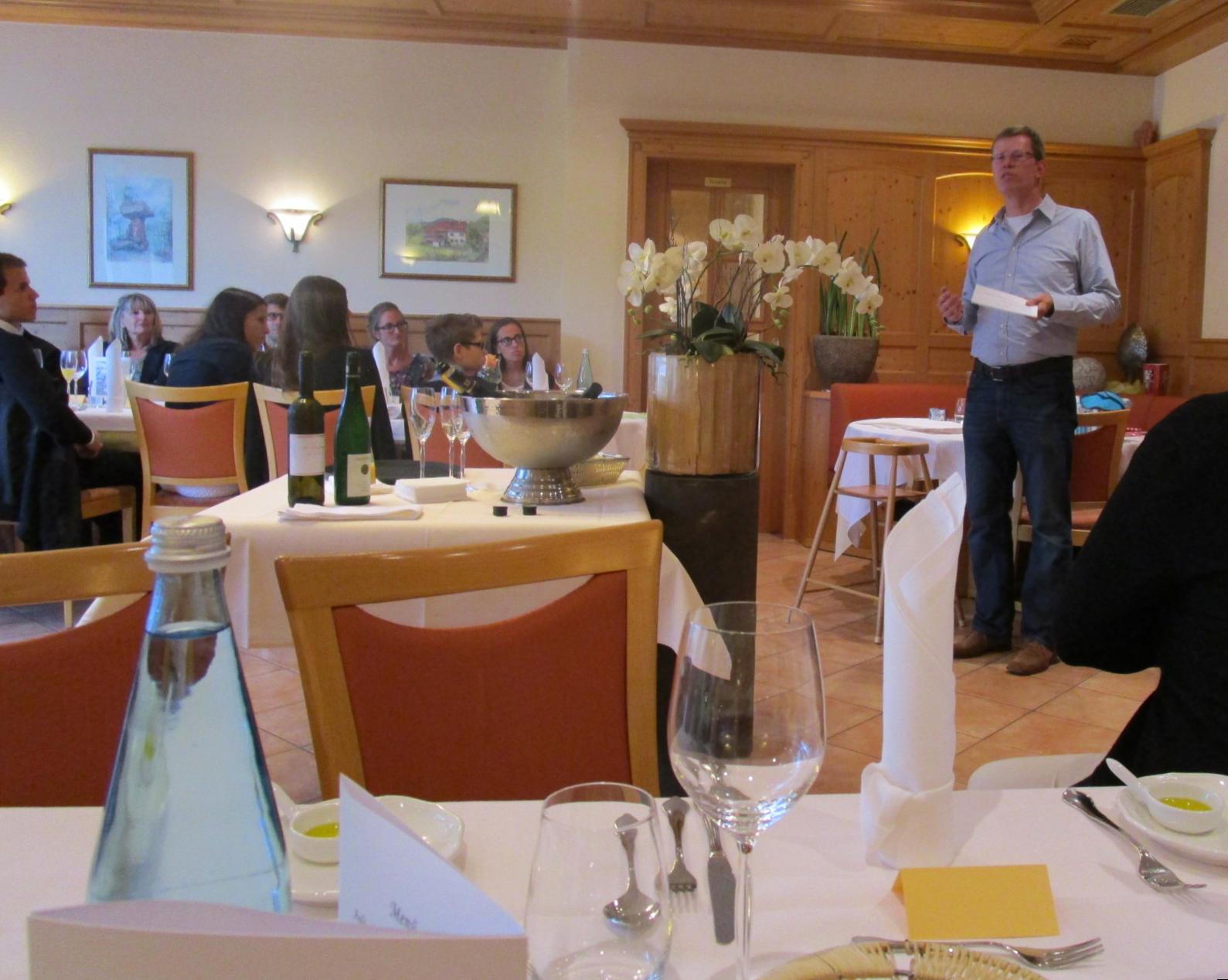 I got my first look at my other new nephew, Theodor, who is now about 6 months old. Just like his mother (my cousin), the cute meter is pegged on this kid, just off the charts. And Theodor got to meet Lukas!
I got my first look at my other new nephew, Theodor, who is now about 6 months old. Just like his mother (my cousin), the cute meter is pegged on this kid, just off the charts. And Theodor got to meet Lukas! The Centre Georges Pompidou is the main modern art museum of Paris, and a place I’ve been trying to get to every time I’m in Paris. On this trip it was my highest priority, and I would finally succeed, but not quite yet. I walked up a little before 11am to find A) they weren’t open yet and B) there was a pretty big line. I’d come back later.
The Centre Georges Pompidou is the main modern art museum of Paris, and a place I’ve been trying to get to every time I’m in Paris. On this trip it was my highest priority, and I would finally succeed, but not quite yet. I walked up a little before 11am to find A) they weren’t open yet and B) there was a pretty big line. I’d come back later.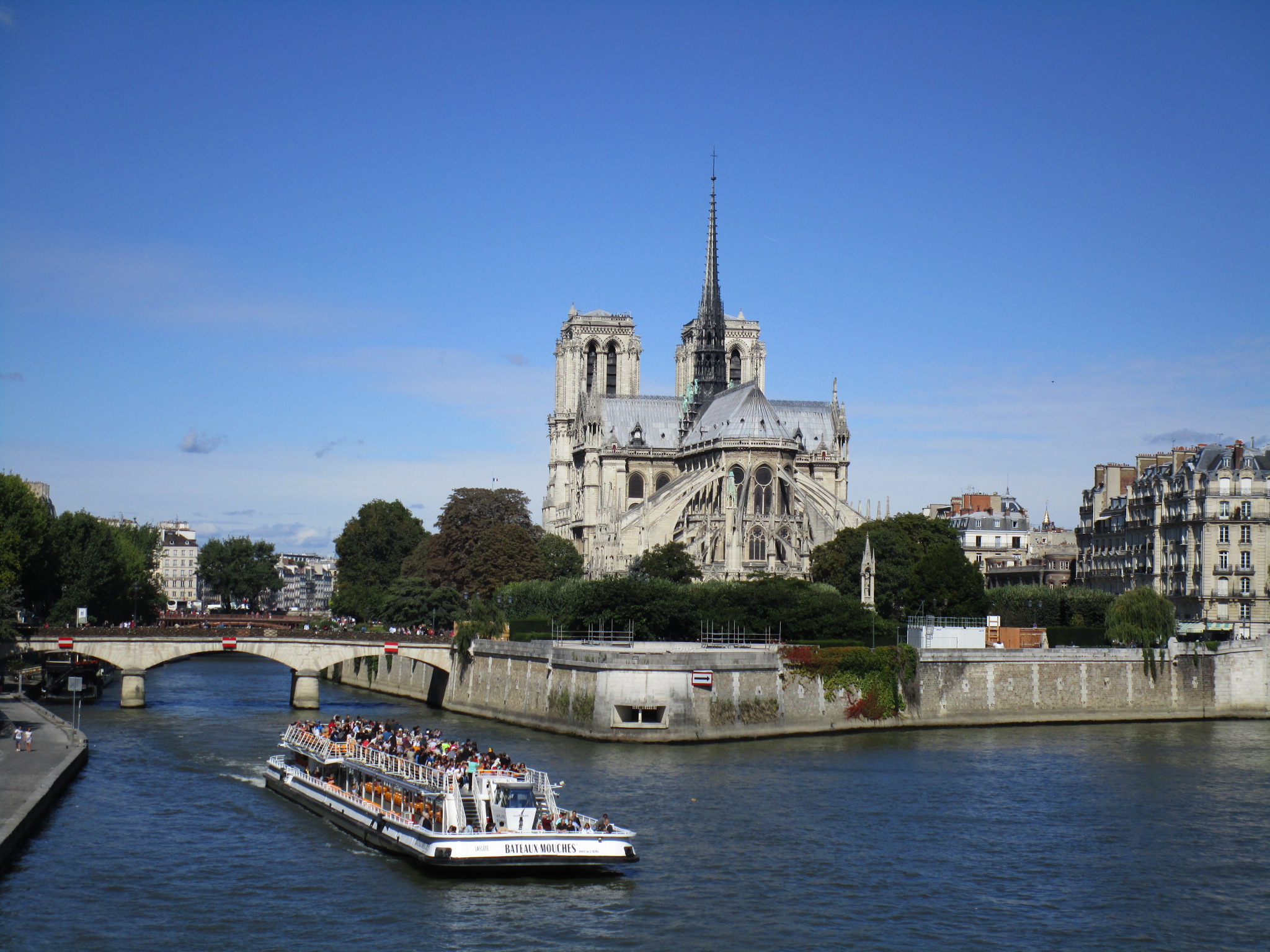 South across the Seine to Ile Saint-Louis (the smaller of the two islands in the river), wandered the streets, passed east of Notre Dame (which I’d get closer to later), and came out on the other side of the river on the Left Bank. Made my way up to the
South across the Seine to Ile Saint-Louis (the smaller of the two islands in the river), wandered the streets, passed east of Notre Dame (which I’d get closer to later), and came out on the other side of the river on the Left Bank. Made my way up to the  The interior you are presented with upon entrance is fabulous and ornate and amazing, with astonishing details wherever you look. For example, seemingly tucked in a corner is a huge mural “Death of St. Genevieve”
The interior you are presented with upon entrance is fabulous and ornate and amazing, with astonishing details wherever you look. For example, seemingly tucked in a corner is a huge mural “Death of St. Genevieve” 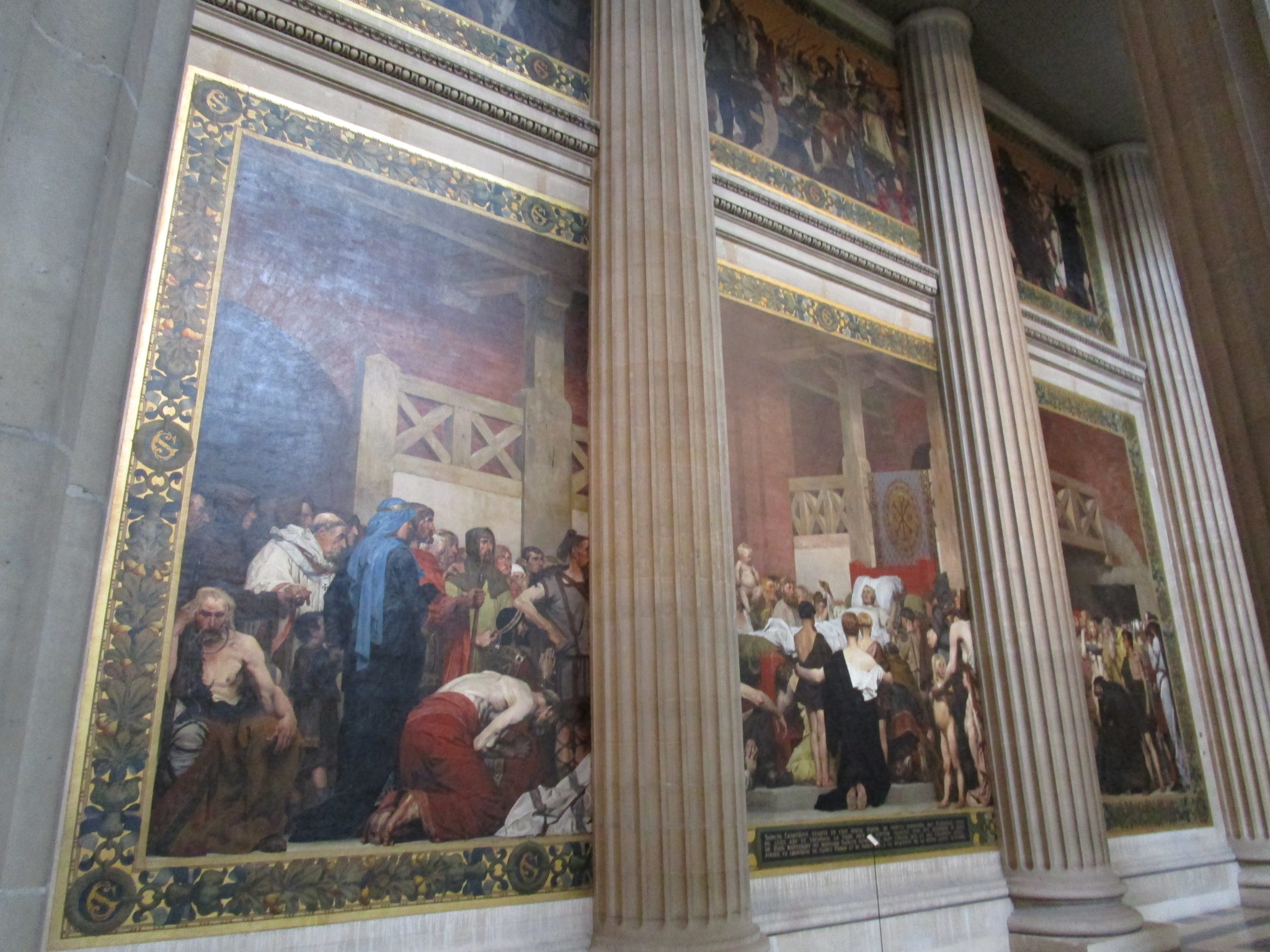 about the
about the 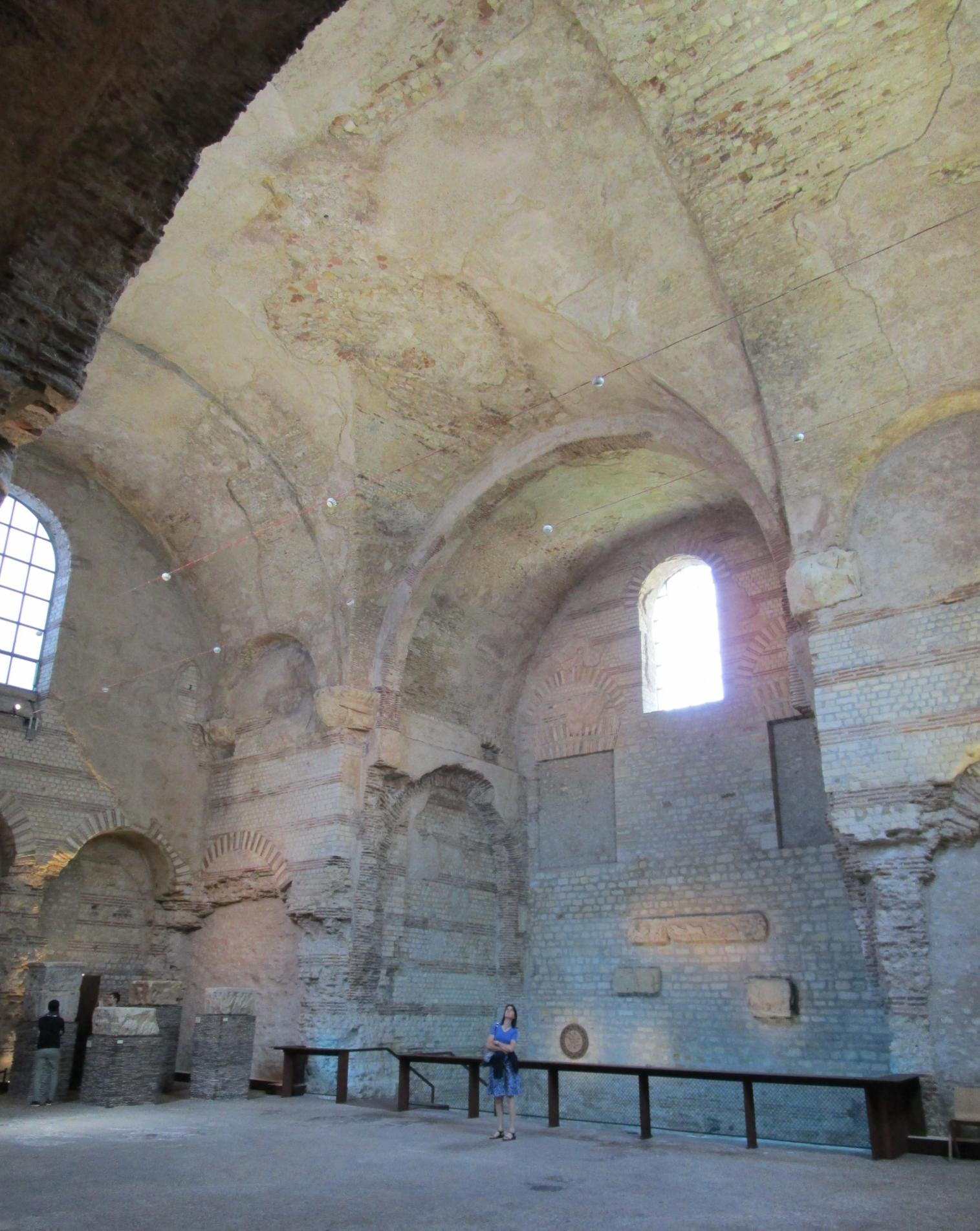 Deep within the museum was an entire
Deep within the museum was an entire 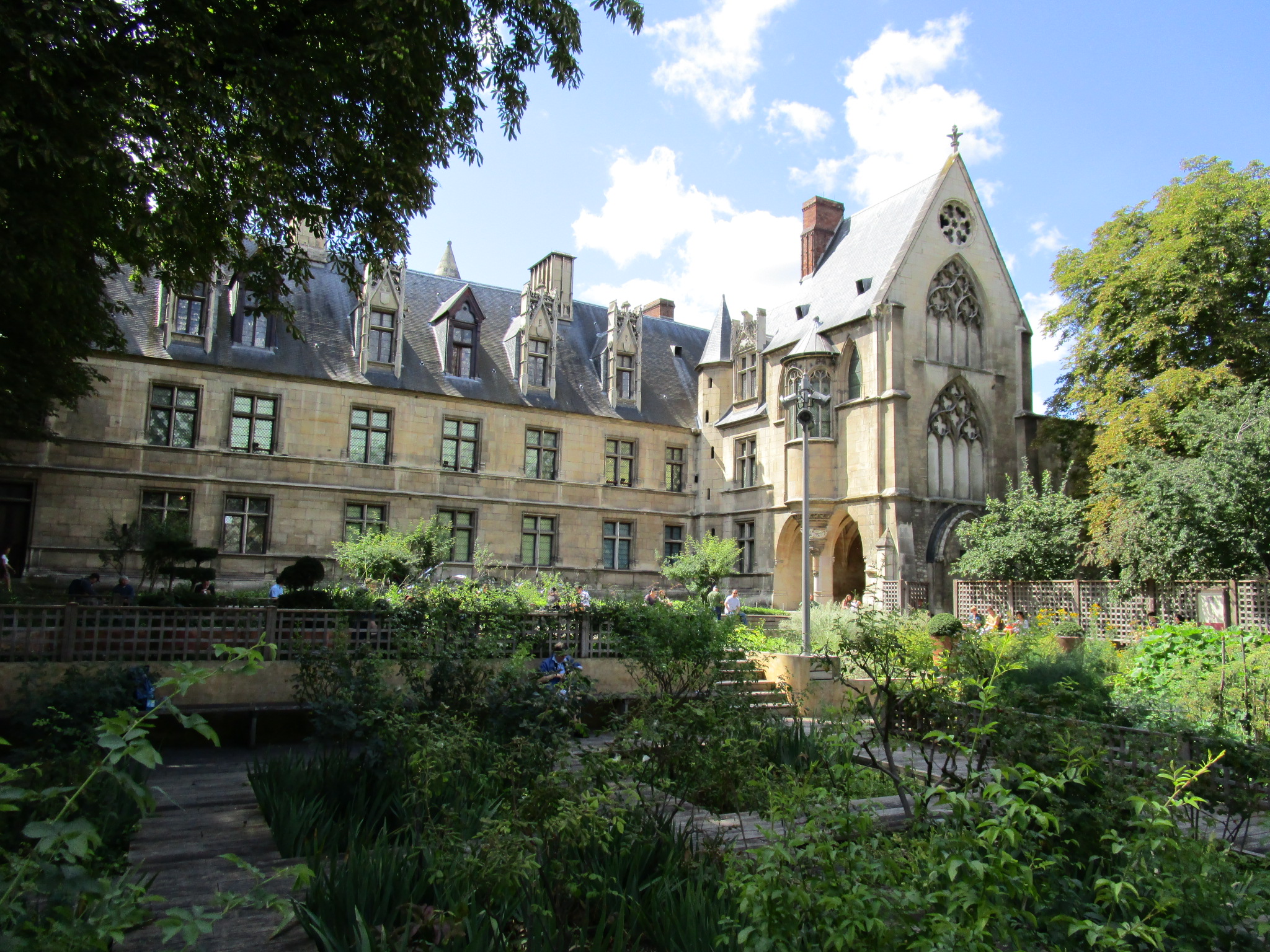 And on the grounds outside were fabulous gardens, full of lunching Parisians, not just tourists. Great place to stop for lunch, so I did.
And on the grounds outside were fabulous gardens, full of lunching Parisians, not just tourists. Great place to stop for lunch, so I did.
 So I wandered around the outside a bit (had already taken
So I wandered around the outside a bit (had already taken 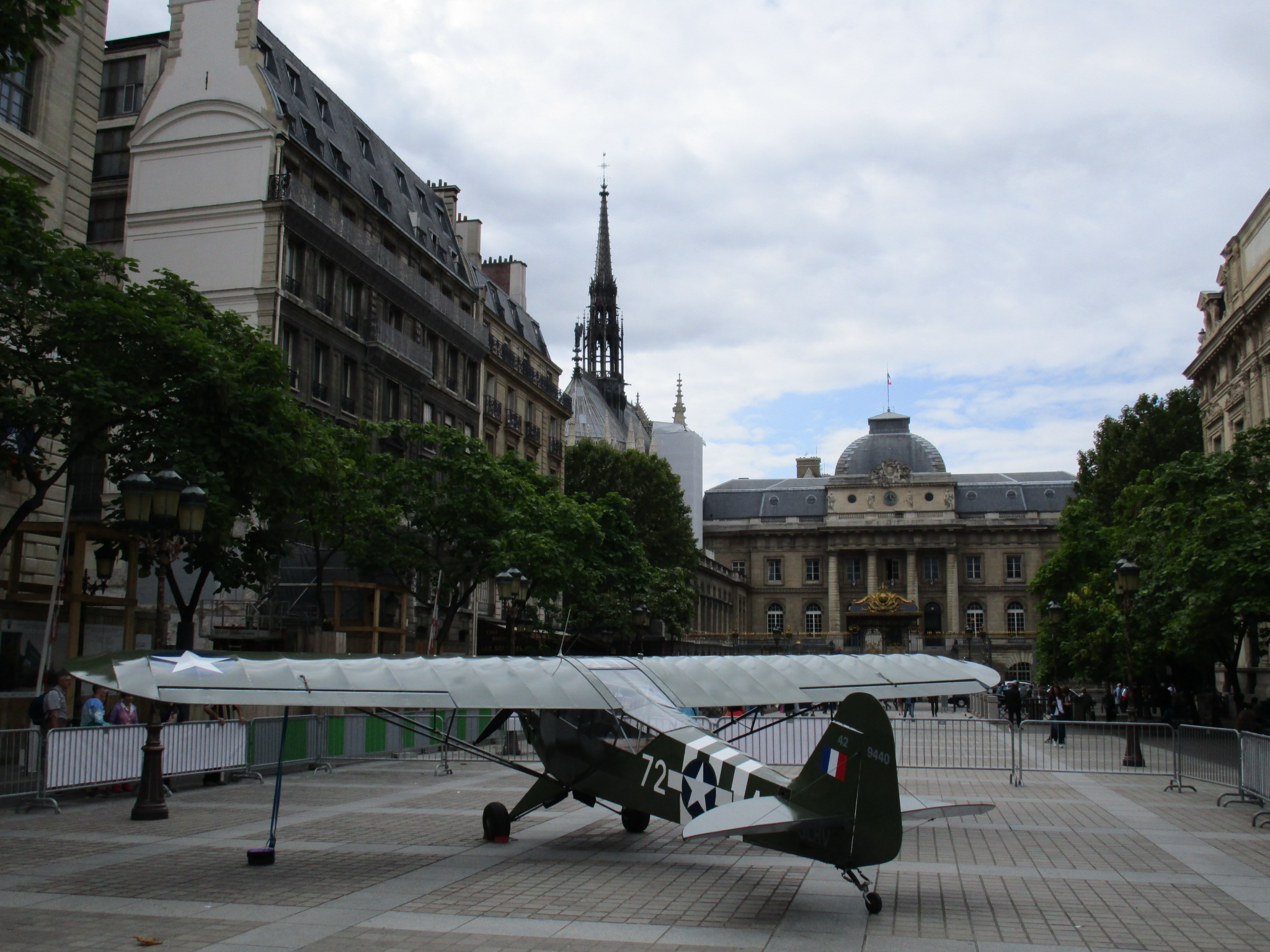 … To a Piper Cub right around the corner. Celebrating the 70th anniversary of the liberation of Paris from the Nazis, the display commemorated the moment on August 24th, 1944, the day before the actual liberation, when Leclerc’s approaching resistance forces flew an aircraft just like this one over this spot, dropping leaflets to the police below saying “
… To a Piper Cub right around the corner. Celebrating the 70th anniversary of the liberation of Paris from the Nazis, the display commemorated the moment on August 24th, 1944, the day before the actual liberation, when Leclerc’s approaching resistance forces flew an aircraft just like this one over this spot, dropping leaflets to the police below saying “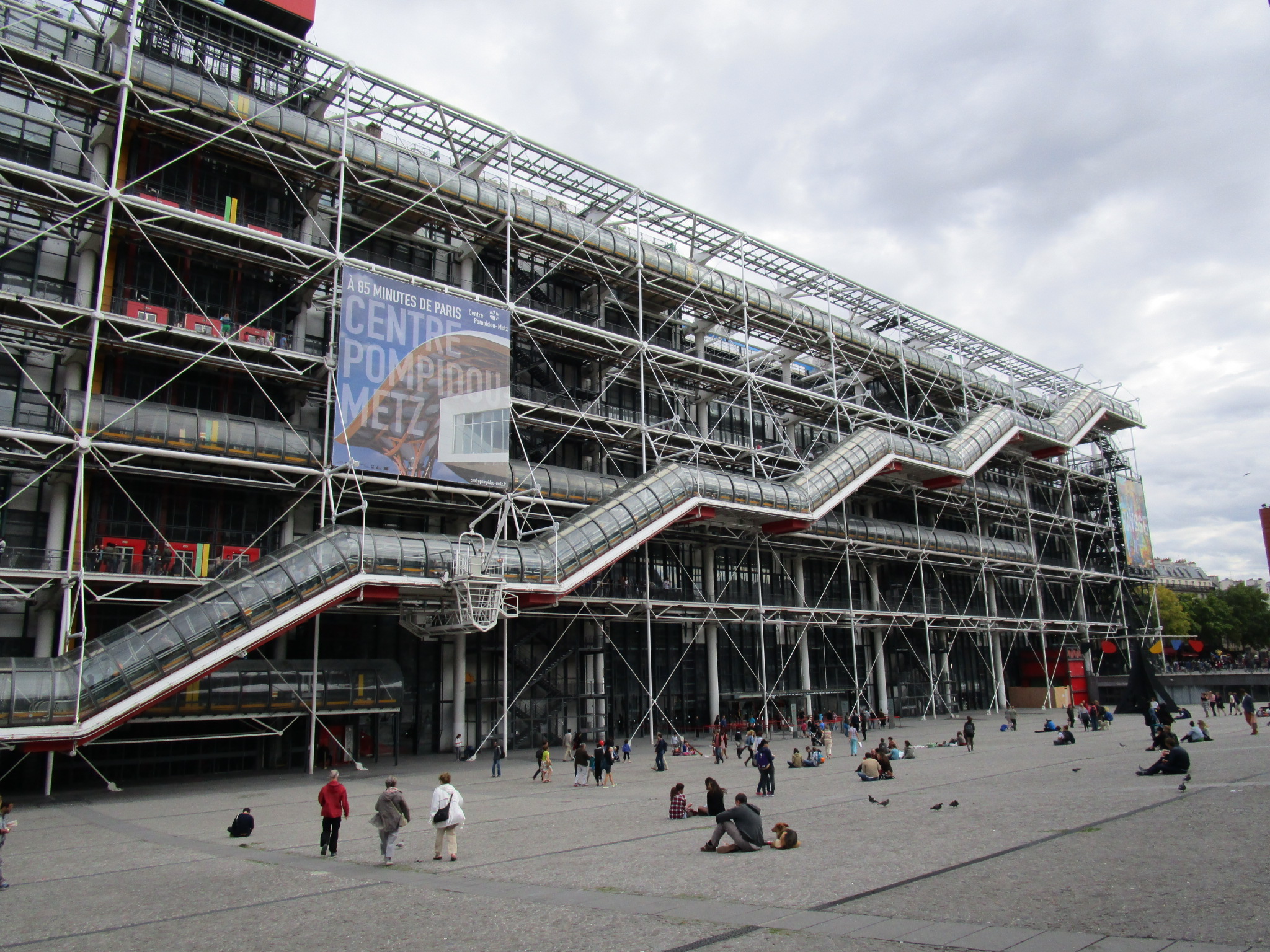 Finally, Centre Georges Pompidou. The most obvious feature of Renzo Piano’s early career design is that it turns a building inside out — putting major structural and functional elements on the outside of the building, instead of hiding them behind a curtain wall. Rode the iconic escalator up to the museum floors, and spent around two hours poring through everything they had.
Finally, Centre Georges Pompidou. The most obvious feature of Renzo Piano’s early career design is that it turns a building inside out — putting major structural and functional elements on the outside of the building, instead of hiding them behind a curtain wall. Rode the iconic escalator up to the museum floors, and spent around two hours poring through everything they had.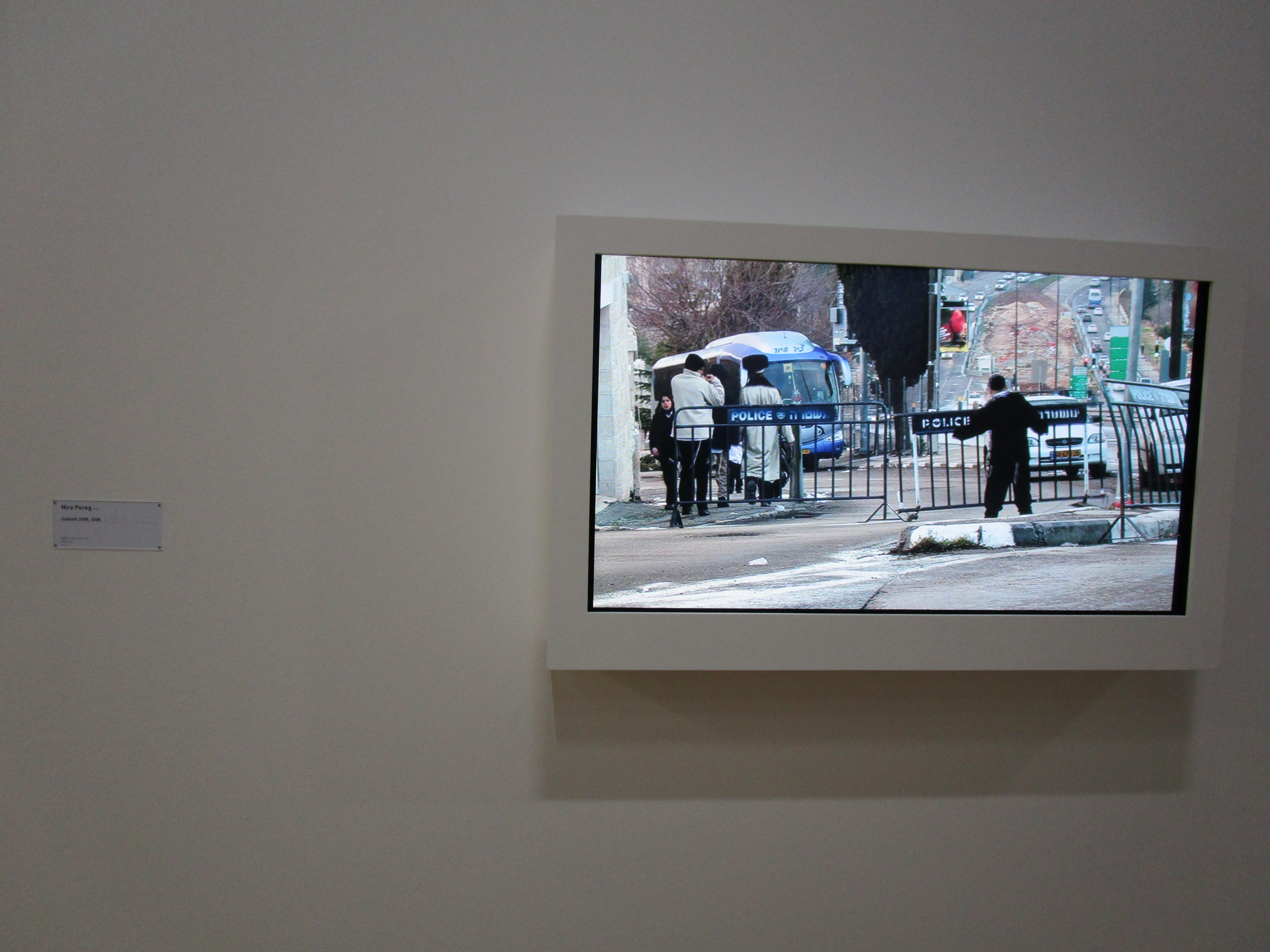 Nina Pereg’s 8-minute video “
Nina Pereg’s 8-minute video “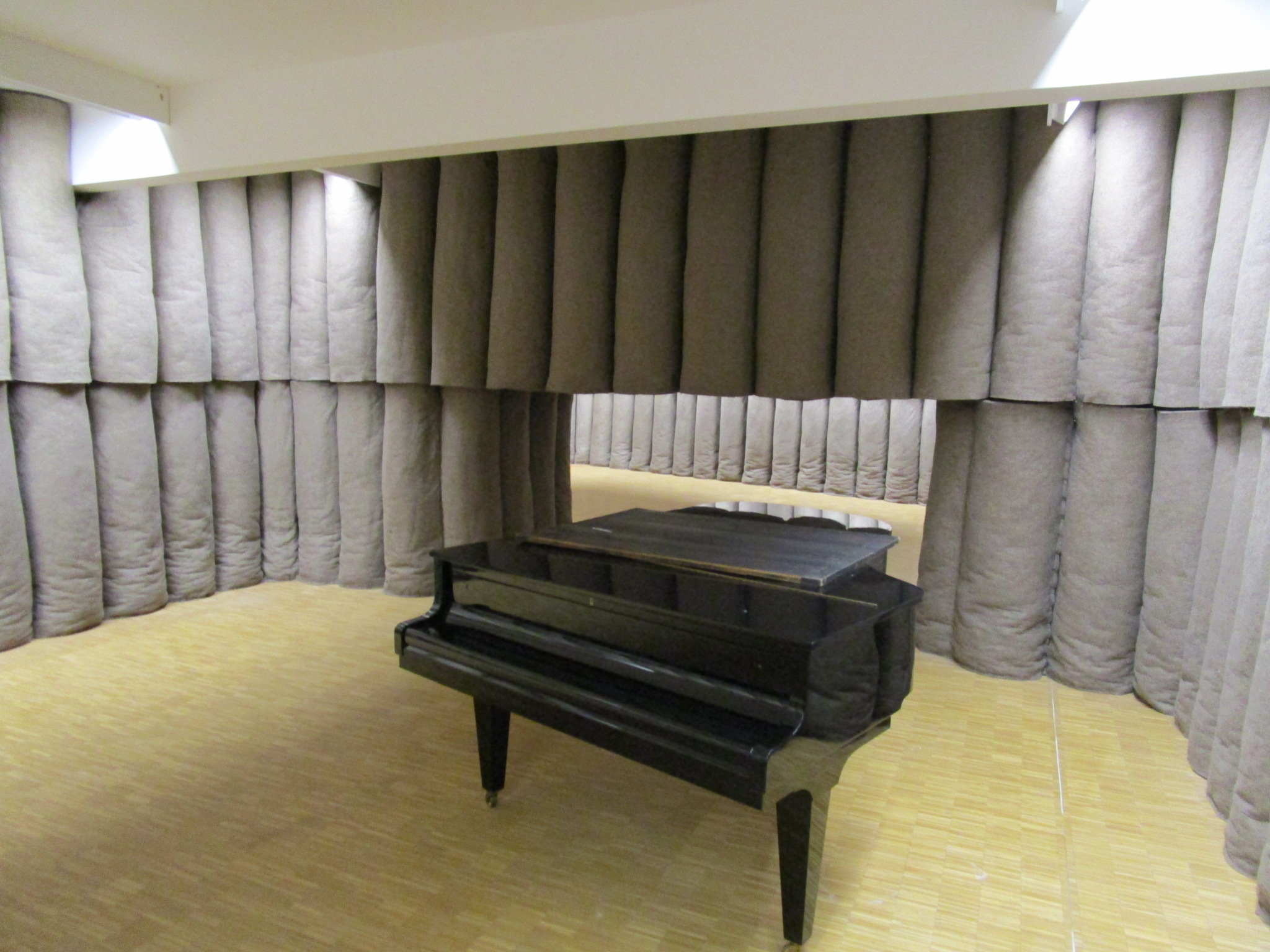 Stooping through a short tunnel-like entrance led to Joseph Beuys’ “
Stooping through a short tunnel-like entrance led to Joseph Beuys’ “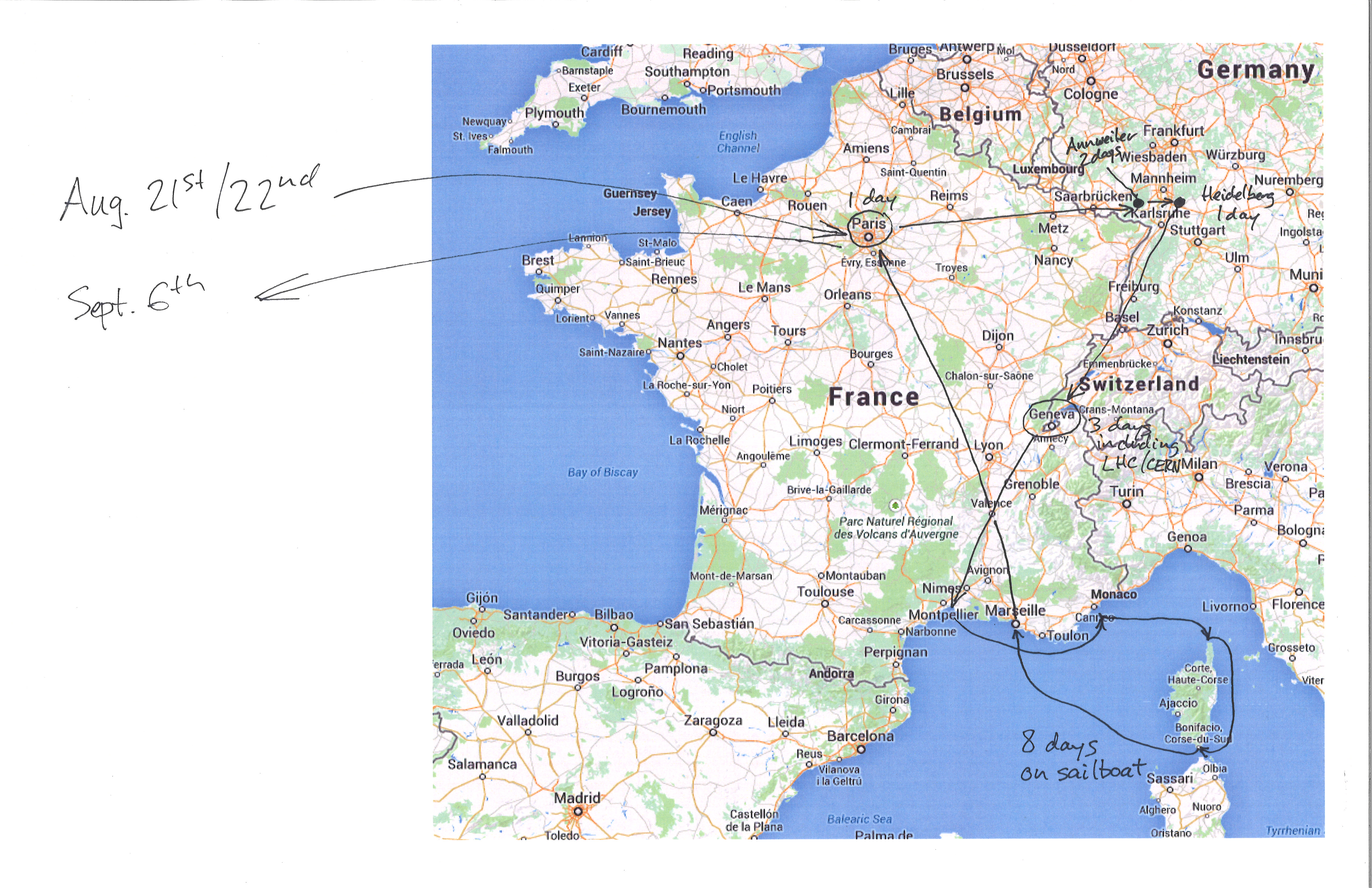
 Next, back on a train to the French coast of the Mediterranean and some sailing!
Next, back on a train to the French coast of the Mediterranean and some sailing! 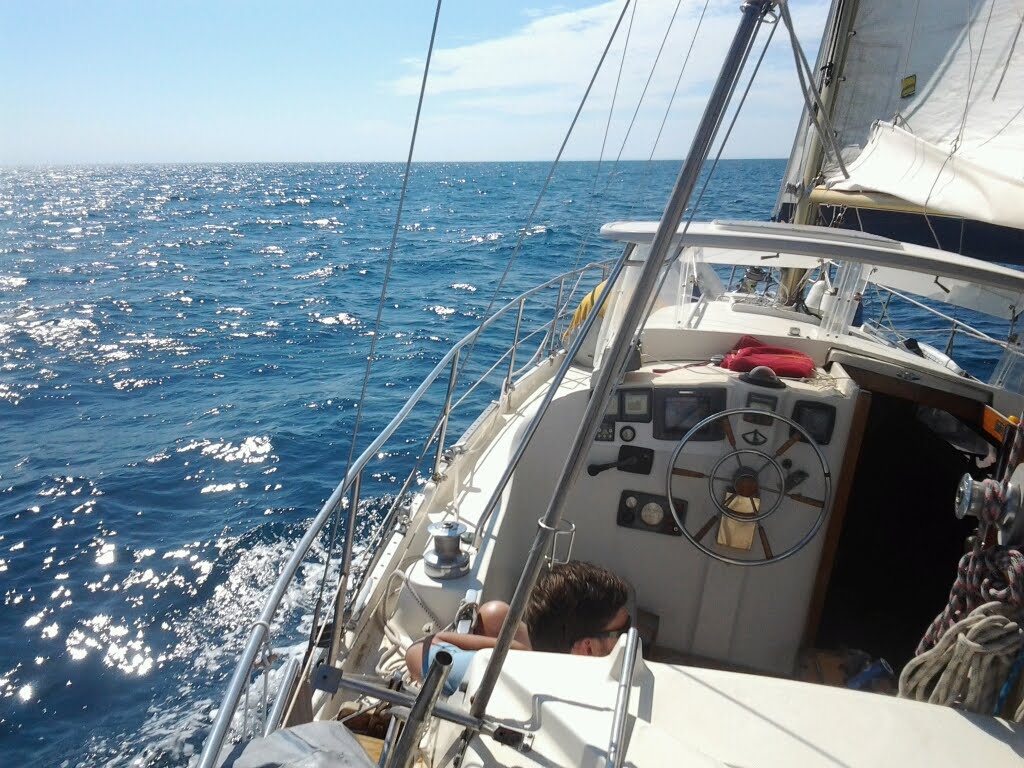 I have been planning this sailing trip for about two years. Two summers ago, Andreas went on two-month trip around the Mediterranean, and was joined by friends and family at various times during the trip. I heard about this and declared my intent to join him someday, and we quickly made plans to target this summer for the trip (2013 was already off the table, I forget why).
I have been planning this sailing trip for about two years. Two summers ago, Andreas went on two-month trip around the Mediterranean, and was joined by friends and family at various times during the trip. I heard about this and declared my intent to join him someday, and we quickly made plans to target this summer for the trip (2013 was already off the table, I forget why). And with that in mind, I really do hope that we get some serious wind. I mean, I’m looking forward to lazing around in the sun, but also to some bare-knuckled tacks and jibes. I don’t think I’m suspectible to seasickness, but I guess I’m going to find out.
And with that in mind, I really do hope that we get some serious wind. I mean, I’m looking forward to lazing around in the sun, but also to some bare-knuckled tacks and jibes. I don’t think I’m suspectible to seasickness, but I guess I’m going to find out. The tentative plan, shown in this last image, will be to disembark from the home port (Port Camargue) and spend eight days workong our way around towards Corsica and back. I really don’t know much about the plan beyond this map, and am leaving myself at the mercy of Andreas and the others.
The tentative plan, shown in this last image, will be to disembark from the home port (Port Camargue) and spend eight days workong our way around towards Corsica and back. I really don’t know much about the plan beyond this map, and am leaving myself at the mercy of Andreas and the others. My mother passed away suddenly in October 2006. In a small ceremony in April 2007, we took her cremated remains and set them in the ground around the base of a newly planted magnolia tree in the backyard of her house.
My mother passed away suddenly in October 2006. In a small ceremony in April 2007, we took her cremated remains and set them in the ground around the base of a newly planted magnolia tree in the backyard of her house. 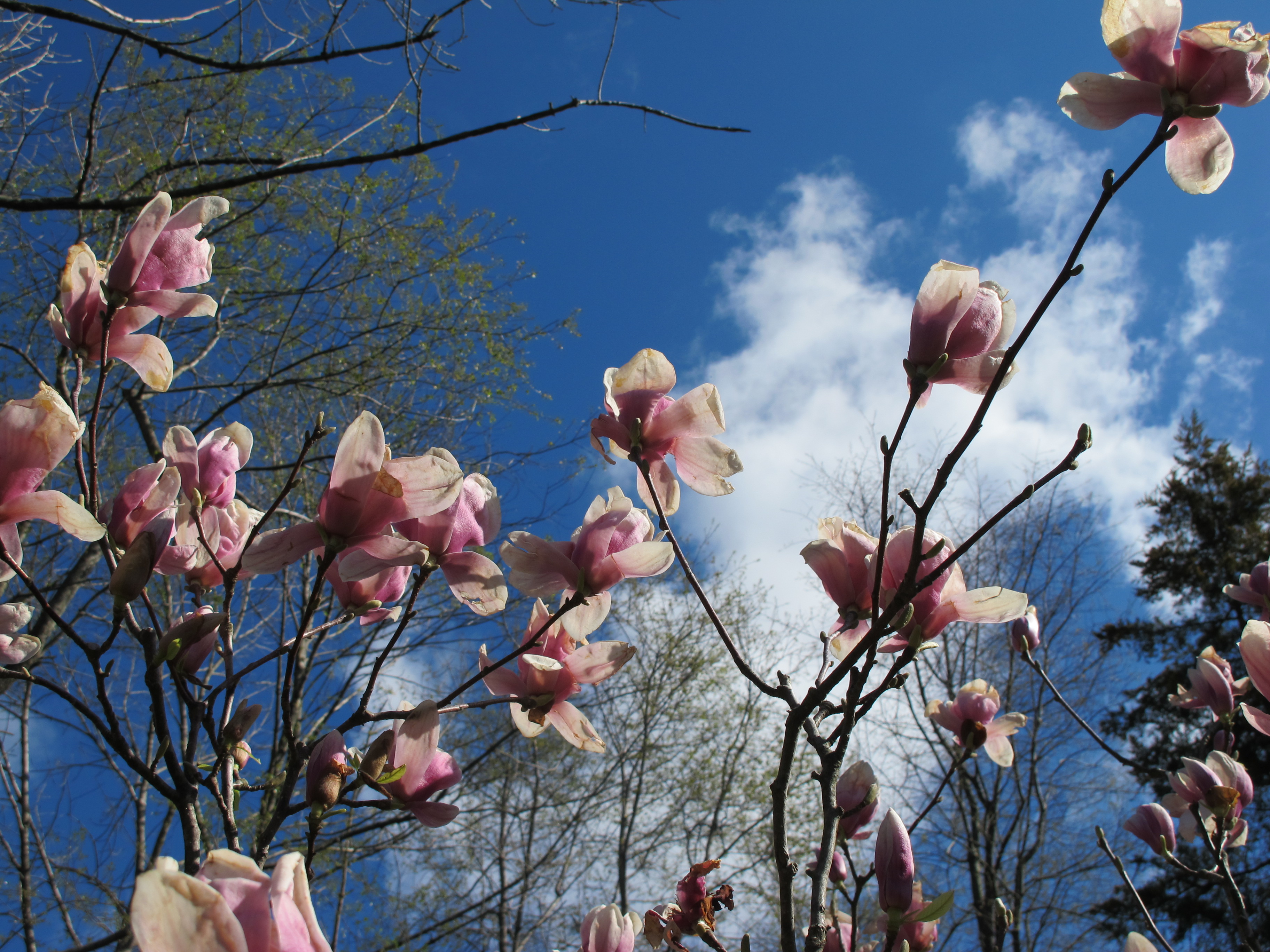 The tree produced a single, full bloom the following spring. The next year it burst forth with over forty blooms, and has flourished since then.
The tree produced a single, full bloom the following spring. The next year it burst forth with over forty blooms, and has flourished since then. the house is finally going on the market after nearly 30 years in family hands. My mother actually built this house to her specifications in the mid 80’s, after getting divorced from Dad and shipping my and my older sister off to college. It really is an incredibly unique and well-built house, with lush landscaping.
the house is finally going on the market after nearly 30 years in family hands. My mother actually built this house to her specifications in the mid 80’s, after getting divorced from Dad and shipping my and my older sister off to college. It really is an incredibly unique and well-built house, with lush landscaping.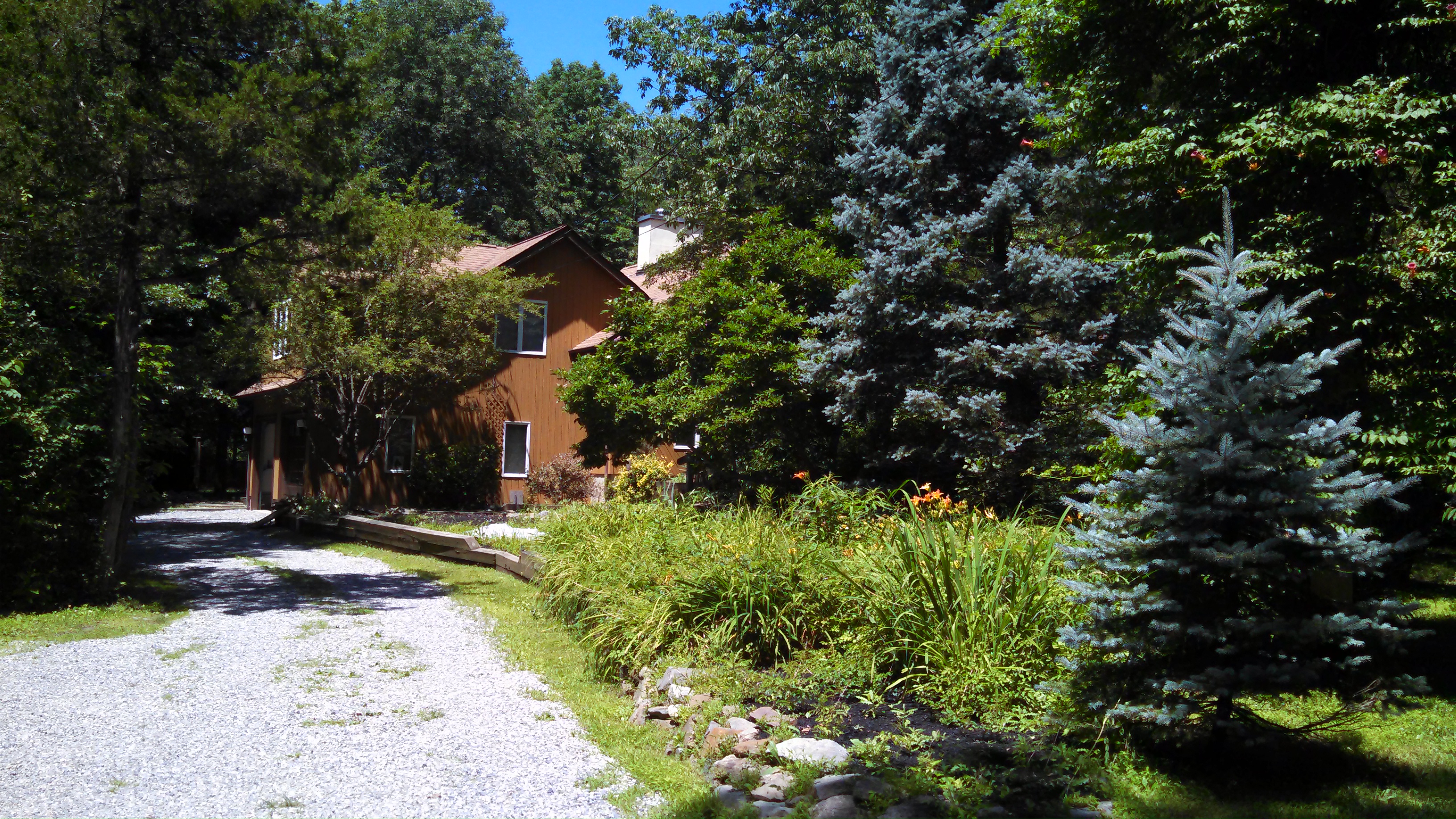 Somebody suggested the idea of doing cuttings of the tree, taking small branch tips and rooting them into new pots. Hmmm, that’s interesting. We talked to professionals and it did indeed seem doable; in fact, my research showed that summer is the ideal time to attempt this. I could take multiple cuttings, to improve the odds of getting at least one to take, and the original tree would still be there.
Somebody suggested the idea of doing cuttings of the tree, taking small branch tips and rooting them into new pots. Hmmm, that’s interesting. We talked to professionals and it did indeed seem doable; in fact, my research showed that summer is the ideal time to attempt this. I could take multiple cuttings, to improve the odds of getting at least one to take, and the original tree would still be there.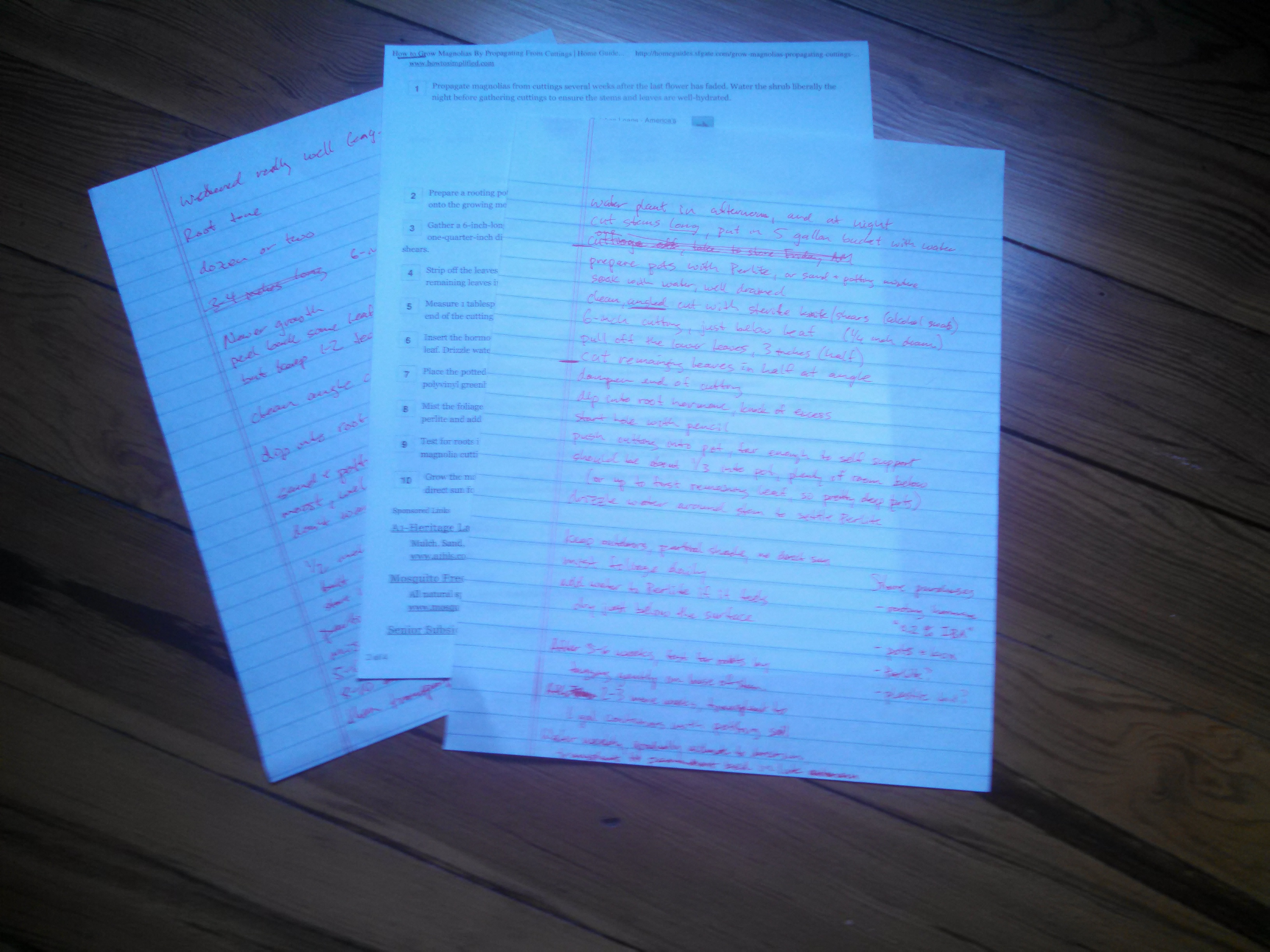 And so I commenced with research on exactly what I needed to do to get tree cuttings to root. Besides the obvious method of searching the internet, I got on the phone with plant expert up in that area and he walked me through the process. Actually I had originally wanted to hire them to do it for me, back before I realized that I really needed to do it myself.
And so I commenced with research on exactly what I needed to do to get tree cuttings to root. Besides the obvious method of searching the internet, I got on the phone with plant expert up in that area and he walked me through the process. Actually I had originally wanted to hire them to do it for me, back before I realized that I really needed to do it myself. On the designated weekend, I flew up and got a good look at the tree — it looked perfectly healthy, if growing a bit oddly. I took one cutting and headed to the local nursery and talked to that expert again (thanks Jeff at Rutgers Nursery!) My original plan had been to to all the potting work in NJ before the drive, but he advised that it would probably be better to just keep the cuttings in water and then do the potting upon arrival.
On the designated weekend, I flew up and got a good look at the tree — it looked perfectly healthy, if growing a bit oddly. I took one cutting and headed to the local nursery and talked to that expert again (thanks Jeff at Rutgers Nursery!) My original plan had been to to all the potting work in NJ before the drive, but he advised that it would probably be better to just keep the cuttings in water and then do the potting upon arrival. So on the day of departure, I went out with a ladder to claim some cuttings. I decided to take 12 cuttings, loosely filling a bucket with them, and put a few inches of water in the bucket. I had brought an old plastic spray bottle with me and filled that up with water to mist the leaves during the drive.
So on the day of departure, I went out with a ladder to claim some cuttings. I decided to take 12 cuttings, loosely filling a bucket with them, and put a few inches of water in the bucket. I had brought an old plastic spray bottle with me and filled that up with water to mist the leaves during the drive.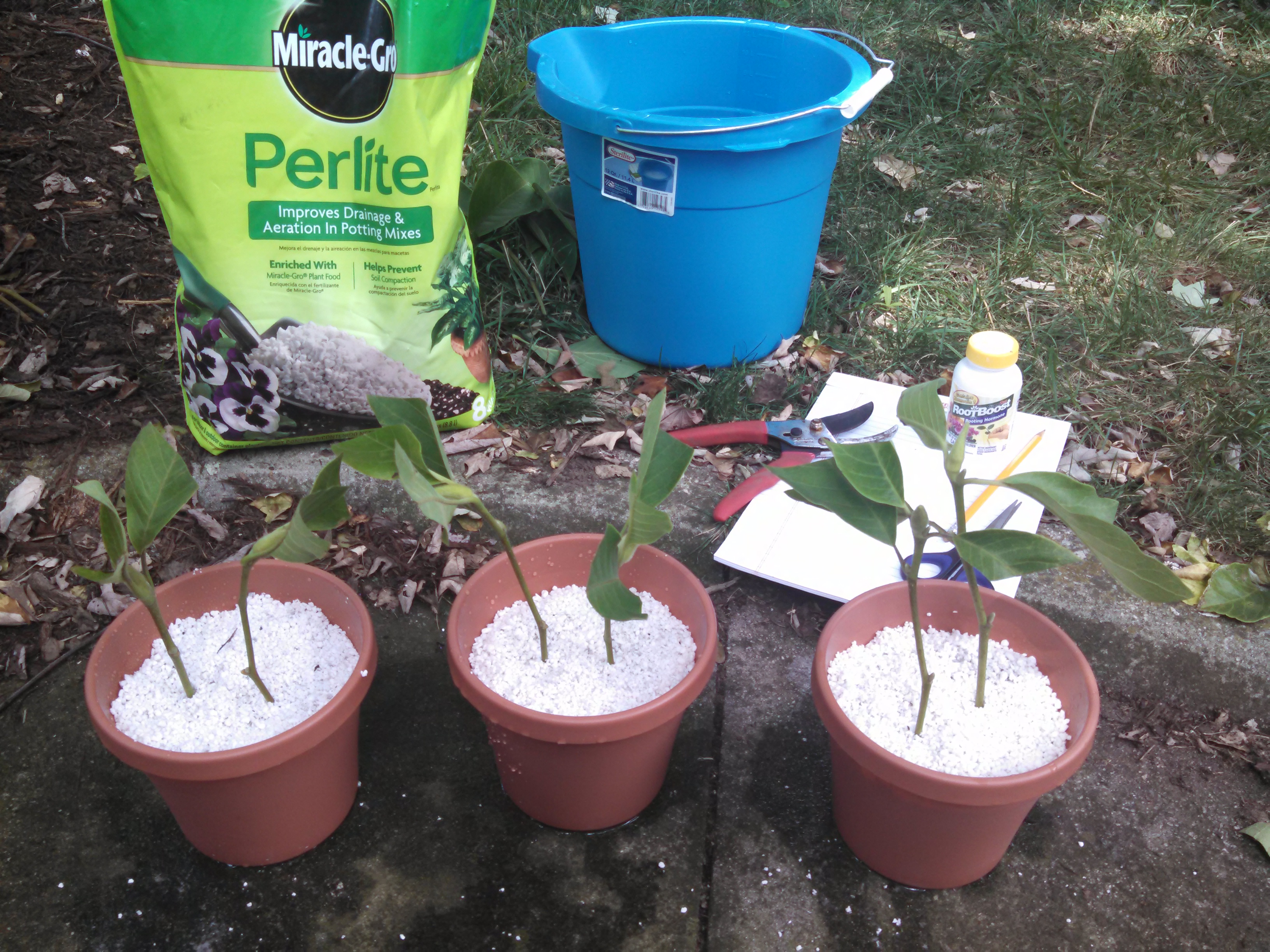 Onwards! I continued to mist the plants at every stop during the drive, and when I arrived at home late that night. The next day I went out and got some Perlite, rooting hormone and pots, and followed the sequence per all my research and notes. Cut just below the node, peel off all but the top two leaves, cut those two remaining leaves in half (to reduce moisture loss), apply rooting hormone to stem tip, place in pots via pencil starter holes, and then water via misting. Of the original twelve cuttings to come down in the bucket, I picked the six most healthy looking.
Onwards! I continued to mist the plants at every stop during the drive, and when I arrived at home late that night. The next day I went out and got some Perlite, rooting hormone and pots, and followed the sequence per all my research and notes. Cut just below the node, peel off all but the top two leaves, cut those two remaining leaves in half (to reduce moisture loss), apply rooting hormone to stem tip, place in pots via pencil starter holes, and then water via misting. Of the original twelve cuttings to come down in the bucket, I picked the six most healthy looking.